Northrop F-5
The Northrop F-5 is a family of supersonic light fighter aircraft initially designed as a privately funded project in the late 1950s by Northrop Corporation. There are two main models, the original F-5A and F-5B Freedom Fighter variants and the extensively updated F-5E and F-5F Tiger II variants. The design team wrapped a small, highly aerodynamic fighter around two compact and high-thrust General Electric J85 engines, focusing on performance and a low cost of maintenance. Smaller and simpler than contemporaries such as the McDonnell Douglas F-4 Phantom II, the F-5 cost less to procure and operate, making it a popular export aircraft. Though primarily designed for a day air superiority role, the aircraft is also a capable ground-attack platform. The F-5A entered service in the early 1960s. During the Cold War, over 800 were produced through 1972 for U.S. allies. Though at the time the United States Air Force (USAF) did not have a need for a light fighter, it did procure approximately 1,200 Northrop T-38 Talon trainer aircraft, which was based on Northrop's N-156 fighter design.
| F-5A/B Freedom Fighter F-5E/F Tiger II | |
|---|---|
 | |
| An F-5E of the Swiss Air Force | |
| Role | Light fighter (Multirole fighter in some upgraded variants) |
| National origin | United States |
| Manufacturer | Northrop Corporation |
| First flight | F-5A: 30 July 1959 F-5E: 11 August 1972 |
| Introduction | 1962 |
| Status | In service |
| Primary users | United States Navy Republic of China Air Force Republic of Korea Air Force Islamic Republic of Iran Air Force |
| Produced | 1959–1987 |
| Number built | A/B/C: 847[1] E/F: 1,399[2] |
| Unit cost |
F-5E: US$2.1 million[3] |
| Developed from | Northrop T-38 Talon |
| Variants | Canadair CF-5 Shaped Sonic Boom Demonstration |
| Developed into | Northrop F-20 Tigershark HESA Azarakhsh HESA Saeqeh HESA Kowsar |
After winning the International Fighter Aircraft Competition, a program aimed at providing effective low-cost fighters to American allies, in 1970 Northrop introduced the second-generation F-5E Tiger II in 1972. This upgrade included more powerful engines, larger fuel capacity, greater wing area and improved leading edge extensions for better turn rates, optional air-to-air refueling, and improved avionics including air-to-air radar. Primarily used by American allies, it remains in US service to support training exercises. It has served in a wide array of roles, being able to perform both air and ground attack duties; the type was used extensively in the Vietnam War.[4] A total of 1,400 Tiger IIs were built before production ended in 1987. More than 3,800 F-5s and the closely related T-38 advanced trainer aircraft were produced in Hawthorne, California.[5] The F-5N/F variants are in service with the United States Navy and United States Marine Corps as adversary trainers.[6] Approximately 500 aircraft were in service as of 2014.[7][N 1]
The F-5 was also developed into a dedicated reconnaissance version, the RF-5 Tigereye. The F-5 also served as a starting point for a series of design studies which resulted in the Northrop YF-17 and the F/A-18 naval fighter aircraft. The Northrop F-20 Tigershark was an advanced variant to succeed the F-5E which was ultimately canceled when export customers did not emerge.
Design and development
Origins
The design effort was led by Northrop vice president of engineering and aircraft designer Edgar Schmued,[8] who previously at North American Aviation had been the chief designer of the successful North American P-51 Mustang and F-86 Sabre fighters. Schmued recruited a strong engineering team to Northrop[9] and assigned them the goal of reversing the trend in fighter development towards greater size and weight in order to deliver an aircraft with high performance, enhanced maneuverability, and high reliability, while still delivering a cost advantage over contemporary fighters.[10][11] Recognizing that expensive jet aircraft could not viably be replaced every few years, he also demanded "engineered growth potential" allowing service longevity in excess of 10 years.[12] Schmued recognized that new jet engine and aerodynamic technology were crucial to these goals, such as the compact but high thrust-to-weight ratio General Electric J85 turbojet engine, and the recently discovered transonic area rule to reduce drag. The J85 engine had been developed to power McDonnell's ADM-20 Quail decoy employed upon the Boeing B-52 Stratofortress.[13] This engine with thrust-to-weight ratios of 6.25 to 7.5 over various versions had a notable thrust per pound advantage over contemporaries, such as the 4.7 thrust-to-weight ratio of the J79 engine used in the F-4 Phantom.[14]
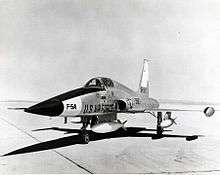
Another highly influential figure was chief engineer Welko Gasich,[15] who convinced Schmued that the engines must be located within the fuselage for maximum performance. Gasich also introduced the concept of "life cycle cost" into fighter design, which provided the foundation for the F-5's low operating cost and long service life. A Northrop design study stated "The application of advanced technology was used to provide maximum force effectiveness at minimum cost. This became the Northrop philosophy in the development of the T-38 and F-5 lightweight trainer and fighter aircraft."[16]
—Singapore's former Chief of Air Force and F-5 pilot, Major General Ng Chee Khern.[17]
The F-5 development effort was formally started in the mid-1950s by Northrop Corporation for a low-cost, low-maintenance fighter. The company designation for the first design as the N-156, intended partly to meet a U.S. Navy requirement for a jet fighter to operate from its escort carriers, which were too small to operate the Navy's existing jet fighters. That requirement disappeared when the Navy decided to withdraw the escort carriers; however Northrop continued development of the N-156, both as a two-seat advanced trainer, designated as N-156T, and a single-seat fighter, designated as N-156F.[18]
The N-156T was quickly selected by the United States Air Force as a replacement for the T-33 in July 1956. On 12 June 1959, the first prototype aircraft, which was subsequently designated as YT-38 Talon, performed its first flight. By the time production had ended in January 1972, a total of 1,158 Talons had been produced.[19][20] Development of the N-156F continued at a lower priority as a private venture by Northrop; on 25 February 1958, an order for three prototypes was issued for a prospective low-cost fighter that could be supplied under the Military Assistance Program for distribution to less-developed nations. The first N-156F flew at Edwards Air Force Base on 30 July 1959, exceeding the speed of sound on its first flight.[21]
Although testing of the N-156F was successful, demonstrating unprecedented reliability and proving superior in the ground-attack role to the USAF's existing North American F-100 Super Sabres, official interest in the Northrop type waned, and by 1960 it looked as if the program was a failure. Interest revived in 1961 when the United States Army tested it, (along with the Douglas A-4 Skyhawk and Fiat G.91) for reconnaissance and close-support. Although all three types proved capable during army testing, operating fixed-wing combat aircraft was legally the responsibility of the Air Force, which would not agree to allow the Army to operate fixed-wing combat aircraft, a situation repeated with the C-7 Caribou.[22]

In 1962, the Kennedy Administration revived the requirement for a low-cost export fighter, selecting the N-156F as winner of the F-X competition on 23 April 1962, subsequently becoming the "F-5A", and was ordered into production in October that year.[23] It was named under the 1962 United States Tri-Service aircraft designation system, which included a re-set of the fighter number series. Northrop manufactured a total of 624 F-5As, including three YF-5A prototypes,[1] before production ended in 1972. A further 200 F-5B two-seat trainer aircraft, lacking nose-mounted cannons but otherwise combat-capable, and 86 RF-5A reconnaissance aircraft, fitted with four-camera noses, were also built. In addition, Canadair built 240 first generation F-5s under license, CASA in Spain built 70 more aircraft.[24]
F-5E and F-5F Tiger II
_061006-F-1234S-067.jpg)
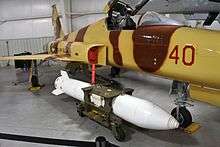
In 1970, Northrop won the International Fighter Aircraft (IFA) competition to replace the F-5A, with better air-to-air performance against aircraft like the Soviet MiG-21. The resultant aircraft, initially known as F-5A-21, subsequently became the F-5E. It had more powerful (5,000 lbf) General Electric J85-21 engines, and had a lengthened and enlarged fuselage, accommodating more fuel. Its wings were fitted with enlarged leading edge extensions, giving an increased wing area and improved maneuverability. The aircraft's avionics were more sophisticated, crucially including a radar (initially the Emerson Electric AN/APQ-153) (the F-5A and B had no radar). It retained the gun armament of two M39 cannons, one on either side of the nose of the F-5A. Various specific avionics fits could be accommodated at a customer's request, including an inertial navigation system, TACAN and ECM equipment.[25]
The first F-5E flew on 11 August 1972.[26] A two-seat combat-capable trainer, the F-5F, was offered, first flying on 25 September 1974, at Edwards Air Force Base, with a new nose, that was three feet longer, which, unlike the F-5B that did not mount a gun, allowed it to retain a single M39 cannon, albeit with a reduced ammunition capacity.[27] The two-seater was equipped with the Emerson AN/APQ-157 radar, which is a derivative of the AN/APQ-153 radar, with dual control and display systems to accommodate the two-men crew, and the radar has the same range of AN/APQ-153, around 10 nmi. On 6 April 1973, the 425th TFS at Williams Air Force Base, Arizona, received the first F-5E Tiger II.[28]
_(cropped).jpg)
A reconnaissance version, the RF-5E Tigereye, with a sensor package in the nose displacing the radar and one cannon, was also offered.
The F-5E eventually received the official name Tiger II; 792 F-5Es, 146 F-5Fs and 12 RF-5Es were eventually built by Northrop.[24] More were built under license overseas: 91 F-5Es and -Fs in Switzerland,[29] 68 by Korean Air in South Korea,[30] and 308 in Taiwan.[31]
The F-5E proved to be a successful combat aircraft in service with U.S. allies, but had no combat service with the U.S. Air Force, though the F-5A with modifications, designated F-5C, was flown by the U.S. in Vietnam.[32] The F-5E evolved into the single-engine F-5G, which was rebranded the F-20 Tigershark. It lost out on export sales to the F-16 in the 1980s.
Upgrades
The F-5E experienced numerous upgrades in its service life, with the most significant one being adopting a new planar array radar, Emerson AN/APQ-159 with a range of 20 nmi to replace the original AN/APQ-153. Similar radar upgrades were also proposed for F-5F, with the derivative of AN/APQ-159, the AN/APQ-167, to replace the AN/APQ-157, but that was cancelled. The latest radar upgrade included the Emerson AN/APG-69, which was the successor of AN/APQ-159, incorporating mapping capability. However, most nations chose not to upgrade for financial reasons, and the radar saw very little service in USAF aggressor squadrons and Swiss Air Force.[33]
Various F-5 versions remain in service with many nations. Singapore has approximately 49 modernized and re-designated F-5S (single-seat) and F-5T (two-seat) aircraft. Upgrades include new FIAR Grifo-F X-band radar from Galileo Avionica (similar in performance to the AN/APG-69), updated cockpits with multi-function displays, and compatibility with the AIM-120 AMRAAM and Rafael Python air-to-air missiles.[17][34][35]
_DARPA_sonic_tests_04.07R.jpg)
One NASA F-5E was given a modified fuselage shape for its employment in the Shaped Sonic Boom Demonstration program carried out by DARPA. It is preserved in the Valiant Air Command Warbird Museum at Titusville, Florida.[36]
The Royal Thai Air Force (RTAF) had their F-5s undergo an extensive upgrade program, resulting in the aircraft re-designated as F-5T Tigris. They are armed with Python III and IV missiles; and equipped with the Dash helmet-mounted cueing system.[37]
Similar programs have been carried out in Chile and Brazil with the help of Elbit. The Chilean upgrade, called the F-5 Tiger III Plus, incorporated a new Elta EL/M-2032 radar and other improvements. The Brazilian program, re-designated as F-5M, adds a new Grifo-F radar along with several avionics and cockpit refurbishments, including the Dash helmet. The F-5M has been equipped with new weapon systems such as the Beyond Visual Range Derby missile, Python IV short-range air-to-air missile, SMKBs smart bomb,[38] and several other weapons.[39][40][41][42]
Operational history
United States
The first contract for the production F-5A was issued in 1962, the first overseas order coming from the Royal Norwegian Air Force on 28 February 1964. It entered service with the 4441st Combat Crew Training Squadron, USAF, at Williams Air Force Base, which had the role of training pilots and ground crew for customer nations, on 30 April that year. At that point, it was still not intended that the aircraft be used in significant numbers by the USAF itself.[43]
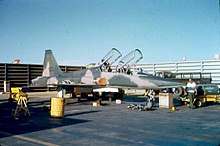
This changed with testing and limited deployment in 1965. Preliminary combat evaluation of the F-5A began at the Air Proving Ground Center, Eglin AFB, Florida, during the summer of 1965 under project Sparrow Hawk, with one airframe lost through pilot error on 24 June.[44] In October 1965, the USAF began a five-month combat evaluation of the F-5A titled Skoshi Tiger. A total of 12 aircraft were delivered for trials to the 4503rd Tactical Fighter Squadron, and after modification with probe and drogue aerial refueling equipment, armor and improved instruments, were redesignated F-5C.[45] Over the next six months, they performed combat duty in Vietnam, flying more than 2,600 sorties, both from the 3rd Tactical Fighter Wing at Bien Hoa over South Vietnam and from Da Nang Air Base where operations were flown over Laos. Nine aircraft were lost in Vietnam, seven to enemy ground fire and two to operational causes.[46][47] Although declared a success, with the aircraft generally rated as capable a ground-attack aircraft as the F-100, but suffering from a shorter range,[48] the program was considered a political gesture intended to aid the export of more F-5s than a serious consideration of the type for U.S. service.[45] From April 1966, the aircraft continued operations as 10th Fighter Commando Squadron with their number boosted to 17 aircraft. (Following Skoshi Tiger the Philippine Air Force acquired 23 F-5A and B models in 1965. These aircraft, along with remanufactured Vought F-8 Crusaders, eventually replaced the Philippine Air Force's F-86 Sabre in the air defense and ground attack roles.)
_061006-F-1234S-083.jpg)
In June 1967, the 10th FCS's surviving aircraft were supplied to the Republic of Vietnam Air Force (RVNAF), which previously had only Douglas A-1 Skyraider attack aircraft. This new RVNAF squadron was titled the 522nd Fighter Squadron. The president of South Vietnam had originally asked for F-4 Phantoms used by the Americans, but the RVNAF flew primarily ground support as the Communist forces employed no opposing aircraft over South Vietnam. Following the Fall of Saigon in 1975, captured examples were used operationally by the Vietnam People's Air Force (VPAF), in particular against Khmer Rouge. In view of the performance, agility and size of the F-5, it might have appeared to be a good match against the similar MiG-21 in air combat; however, U.S. doctrine was to use heavy, faster and longer-range aircraft like the Republic F-105 Thunderchief and McDonnell Douglas F-4 Phantom II over North Vietnam. 41 F-5s were captured by the People's Army of Vietnam when they defeated South Vietnam on 30 April 1975; of the captured equipment, the Soviets took delivery of a complete F-5E, along with various spare parts and support equipment;[49] aircraft would arrive in Poland and Russia for study of U.S. aviation technology,[50] while others were decommissioned and put on display at museums in Vietnam.
The F-5 was also adopted as an opposing forces (OPFOR) "aggressor" for dissimilar training role because of its small size and performance similarities to the Soviet MiG-21. In realistic trials at Nellis AFB in 1977, the F-14 reportedly scored slightly better than a 2:1 kill ratio against the simpler F-5, while the F-15 scored slightly less.[51][52][53][54] There is some contradiction of these reports, another source reports that "For the first three weeks of the test, the F-14s and F-15s were hopelessly outclassed and demoralized"; after adapting to qualities of the F-5 and implementing rule changes to artificially favor long range radar-guided missiles, "the F-14s did slightly better than breaking even with the F-5s in non-1 v 1 engagements; the F-15s got almost 2:1".[55] A 2012 Discovery Channel documentary Great Planes reported that in USAF exercises, F-5 aggressor aircraft were competitive enough with more modern and expensive fighters to only be at small disadvantage in Within Visual Range (WVR) combat.[56]
The F-5E served with the U.S. Air Force from 1975 until 1990, in the 64th Aggressor Squadron and 65th Aggressor Squadron at Nellis Air Force Base in Nevada, and with the 527th Aggressor Squadron at RAF Alconbury in the UK and the 26th Aggressor Squadron at Clark Air Force Base in the Philippines. The U.S. Marines purchased used F-5s from the Air Force in 1989 to replace their F-21s, which served with VMFT-401 at Marine Corps Air Station Yuma. The U.S. Navy used the F-5E extensively at the Naval Fighter Weapons School (TOPGUN) when it was located at NAS Miramar, California. When TOPGUN relocated to become part of the Naval Strike and Air Warfare Center at NAS Fallon, Nevada, the command divested itself of the F-5, choosing to rely on VC-13 (redesignated VFC-13 and which already used F-5s) to employ their F-5s as adversary aircraft. Former adversary squadrons such as VF-43 at NAS Oceana, VF-45 at NAS Key West, VF-126 at NAS Miramar, and VFA-127 at NAS Lemoore have also operated the F-5 along with other aircraft types in support of Dissimilar Air Combat Training (DACT).
The U.S. Navy F-5 fleet continues to be modernized with 36 low-hour F-5E/Fs purchased from Switzerland in 2006. These were updated as F-5N/Fs with modernized avionics and other improved systems. Currently, the only U.S. Navy and U.S. Marine Corps units flying the F-5 are VFC-13 at NAS Fallon, Nevada, VFC-111 at NAS Key West, Florida, and VMFT-401 at MCAS Yuma, Arizona.[6] Currently, VFC-111 operates 18 Northrop F-5N/F Tiger IIs. 17 of these are single-seater F-5Ns and the last is a twin-seater F-5F "FrankenTiger", the product of grafting the older front-half fuselage of an F-5F into the back-half fuselage of a newer low-hours F-5E acquired from the Swiss Air Force. A total of three "FrankenTigers" were made.[57]
According to the FAA, there are 18 privately owned F-5s in the U.S., including Canadair CF-5Ds.[58][59]
Brazil
_Seguran%C3%A7a_Rio_2016_(3).jpg)
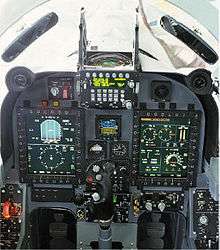
In October 1974, the Brazilian Air Force (FAB) ordered 36 F-5E and 6 F-5B aircraft from Northrop for $72 million. The first three aircraft arrived on 12 March 1975.[60] In 1988, FAB acquired 22 F-5E and four F-5F second-hand USAF "aggressor" fighters. A total of 15 of these aircraft were part of the initial batch of 30 aircraft produced by Northrop.[61] In 1990, FAB retired all remaining five F-5Bs; later, they were sent to Brazilian museums around the country.[62]
In 2001, Elbit Systems and Embraer started work on a $230 million Brazilian F-5 modernization program, performed over an eight-year period, upgrading 46 F-5E/F aircraft, re-designated as F-5EM and F-5FM. The modernization centered on several areas: new electronic warfare systems, the Grifo F radar, an air-to-air refueling system, INS/GPS-based navigation, support for new weapons, targeting and self-defense systems, HOTAS, LCD displays, helmet-mounted displays (HMDs), Radar Warning Receiver, encrypted communications, cockpit compatibility for night vision goggles, On-Board Oxygen Generation System (OBOGS) and various new onboard computer upgrades. One important capability is the secure communication with R-99 airborne early warning platforms and ground stations.[63]
Externally, the new aircraft features a larger nose cone that accommodates the larger radar equipment. The first F-5EM was handed over on 21 September 2005.[64] On 7 July 2003, four Rafael Litening III targeting pods were ordered at a cost of US$13 million,[65] to be used on F-5M together with three Rafael Sky Shield jamming pods ordered on 5 July 2006 at a cost of US$42 million.[66]
In 2009, FAB bought eight single-seat and three twin-seat F-5F used aircraft from Jordan in a US$21 million deal. These aircraft were built between 1975 and 1980.[67] On 14 April 2011, a contract of $153 million was signed with Embraer and Elbit to modernize the additional F-5s bought from Jordan, and to supply one more flight simulator as a continuation of the contract signed in 2000. These F-5s will receive the same configuration as those from the initial 46 F-5s currently completing the upgrade process. The first delivery of this second batch of upgraded jet fighters is scheduled for 2013 with expected use to 2030.[68][69]
Ethiopia
Ethiopia received 10 F-5As and two F-5Bs from the U.S. starting in 1966. In addition to these, Ethiopia had a training squadron equipped with at least eight Lockheed T-33 Shooting Stars. In 1970, Iran transferred at least three F-5As and Bs to Ethiopia. In 1975, another agreement was reached with the U.S. to deliver a number of military aircraft, including 14 F-5Es and three F-5Fs; later in the same year eight F-5Es were transferred while the others were embargoed and delivered to a USAF aggressor Squadron due to the changed political situation. The U.S. also withdrew its personnel and cut diplomatic relations. Ethiopian officers contracted a number of Israelis to maintain American equipment.[70]
The Ethiopian F-5 fighters saw combat action against Somali forces during the Ogaden War (1977–1978). The main Somali fighter aircraft was the MiG-21MF delivered in the 1970s, supported by Mikoyan-Gurevich MiG-17s delivered in the 1960s by the Soviet Union. Ethiopian F-5E aircraft were used to gain air superiority because they could use the AIM-9B air-to-air missile, while the F-5As were kept for air interdiction and airstrike. During this period Ethiopian F-5Es went on training against Ethiopian F-5As and F-86 Sabres (simulating Somali MiG-21s and MiG-17s).[70]
On 17 July 1977, two F-5s were on combat air patrol near Harer, when four Somali MiG-21MFs were detected nearby. In the engagement, two MiG-21s were shot down while the other two had a midair collision while avoiding an AIM-9B missile. The better-trained F-5 pilots swiftly gained air superiority over the Somali Air Force, shooting down a number of aircraft, while other Somali aircraft were lost to air defense and to incidents. Records indicate that Ethiopian F-5s of the 9th Fighter Squadron "shot down 13 MiGs-17 and 12 MiGs-21 from 20th July until 1st September 1977. All aircraft were hit by Sidewinders (AIM-9)." [71] However at least three F-5s were shot down by air defense forces during attacks against supply bases in western Somalia.[70]
Ethiopian pilots who had flown both the F-5 and the MiG-21 considered the F-5 to be the superior fighter because of its manoeuvrability at low to medium speeds and the fact that is was far easier to fly, allowing the pilot to focus on combat rather than controlling his airplane.[72]. This effect was enhanced by the poor quality of pilot training provided by the Soviets, which provided limited flight time and focussed exclusively on taking off and landing, with no practical training in air combat.[72][73].
Ethiopia's ace pilot and national hero was Legesse Tefera who is credited with shooting down 6 (or 7) Somali MiGs, thus making him the most successful F-5 pilot ever.[74][75][76][77]
Iran

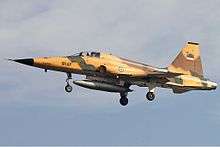
The Imperial Iranian Air Force (IIAF) received extensive U.S. equipment in the 1960s and 1970s. Iran received its first 11 F-5As and two F-5Bs in February 1965 which were then declared operational in June 1965. Ultimately, Iran received 104 F-5As and 23 F-5Bs by 1972. From January 1974 with the first squadron of 28 F-5Fs, Iran received a total of 166 F-5E/Fs and 15 additional RF-5As with deliveries ending in 1976. While receiving the F-5E and F, Iran began to sell its F-5A and B inventory to other countries, including Ethiopia, Turkey, Greece and South Vietnam; by 1976, many had been sold, except for several F-5Bs retained for training purposes.[78] F-5s were also used by the IIAF's aerobatic display team, the Golden Crown.
After the Iranian revolution in 1979, the new Islamic Republic of Iran Air Force (IRIAF) was partially successful at keeping Western fighters in service during the Iran–Iraq War in the 1980s and the simple F-5 had a good service readiness until late in the war. Initially Iran took spare parts from foreign sources; later it was able to have its new aircraft industry keep the aircraft flying.[79]
IRIAF F-5s were heavily involved, flying air-to-air and air-to-ground sorties. Iranian F-5s took part in air combat with Iraqi Mikoyan-Gurevich MiG-21, Mikoyan-Gurevich MiG-23, Mikoyan-Gurevich MiG-25, Su-20/22, Mirage F-1 and Super Etendards. The exact combat record is not known with many differing claims from Iraqi, Iranian, Western, and Russian sources. There are reports that an IRIAF F-5E, piloted by Major Yadollah Javadpour, shot down a MiG-25 on 6 August 1983.[80][81] Russian sources state that the first confirmed kill of a MiG-25 occurred in 1985.[82]
During the first years of service, Iranian F-5 fighter aircraft had the advantage in missile technology, using advanced versions of the IR seeking Sidewinder, later lost with deliveries of new missiles and fighters to Iraq.[83]
Iran Aircraft Manufacturing Industrial Company currently produces three aircraft, the Azarakhsh, Saeqeh, and Kowsar, derived from the F-5.[84]
Kenya
Starting on 16 October 2011 during Operation Linda Nchi, Kenyan Air Force F-5s supported the Kenyan forces fighting in Somalia against Al Shabab Islamists bombing targets inside Somalia and spearheading the ground forces.[85]
Malaysia
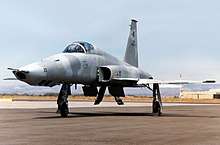
In 1975, the Royal Malaysian Air Force received 14 F-5Es and two F-5Bs. In 1982, four F-5Fs were received and the two F-5Bs already in Malaysian service were transferred to the Royal Thai Air Force. In 1983, RMAF received two RF-5E Tigereye. Subsequently, two F-5Es and a F-5F were ordered as attrition replacement. The F-5E was the first supersonic fighter in Royal Malaysian Air Force service and it replaced the former RAAF CAC Sabre as the Royal Malaysian Air Force's primary air defense fighter throughout the 1980s and early '90s. It also served in secondary ground attack role alongside the Douglas A-4 Skyhawk. Two F-5Es and one F-5F were lost in the accident with two fatalities. In 2000, all the RMAF F-5s were deactivated, but they were reactivated in 2003 as the Tactical Air Reconnaissance Squadron and Reserve. Several upgrade packages were proposed to extend the service life of the aircraft, but none were taken. In 2015, the F-5s was pulled out of service, but some were kept in storage.
Mexico
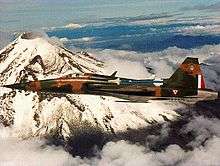
In 1982, the Mexican Air Force received 10 F-5Es and two F-5Fs after the purchase of 24 IAI Kfir C.1 was blocked by the U.S., because the Kfir used the American-produced J79 engine. These fighters complemented the Lockheed T-33 and de Havilland Vampire Mk.I (received much earlier), two of the first combat jet aircraft in Mexico. The F-5 gave Mexico its first supersonic warplane, and it saw the formation of Air Squadron 401. On 16 September 1995, after more than 30 military parade flights without incidents, an F-5E collided in midair with three Lockheed T-33s during the military parade for the Independence of Mexico resulting in 10 deaths. As of September 2016, the Mexican Air Force has three F-5 Tigers that are operational and combat-ready.[86]
Morocco
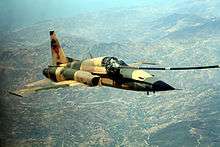
Three F-5As were involved in the failed 1972 Moroccan coup attempt, attacking King Hassan II of Morocco's Boeing 727 in mid-air, before strafing and bombing a military airfield and the royal palace.[87]
Morocco used 28 F-5A/B and 2 RF-5A in the Western Sahara War over Western Sahara. In the 1980s, Morocco received 16 F-5E and four F-5F, fighting against the Polisario Front. Threats faced included multiple SA-6 antiaircraft systems, and several F-5s were lost during the conflict.[88] Starting in 1990, Morocco received 12 more F-5Es from the United States, a total of 24 F-5Es having been upgraded to the F-5TIII standard.
Netherlands
_NF-5B_(CL-226)%2C_Netherlands_-_Air_Force_AN1018960.jpg)
The Royal Netherlands Air Force (RNLAF) received 75 F-5A single seat fighters and 30 F-5B dual–seat trainers. They have been license built in Canada respectively as NF-5As and Bs in the 1969 CL-226 production line. These aircraft equalled the Canadian CF-5A and CF-5D versions with more powerful engines fitted. The first NF-5A was handed over in October 1969 at Twente airbase for 313 Squadron acting as Operational Conversion Unit. The last aircraft was handed over in March 1972. The NF-5As flew under the Dutch registrations K-3001 / K-3075 and the NF-5Bs under K-4002 / K-4030. They have been operational at Twente airbase (OCU, 313 and 315 Squadrons), at Eindhoven airbase (314 Sq) and Gilze-Rijen airbase (316 Sq).
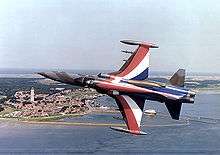
During the RNLAF F-16 transition the NF-5s and Bs have been stored at the Gilze-Rijen and Woensdrecht airbases. 60 aircraft were sold to Turkey, 11 to Greece and 7 to Venezuela. Some aircraft have been written off during their operational life due to crashes and some remaining aircraft are displayed in musea or used in technical schools. The NF-5As and Bs were operational from 1971 to 1991.
Norway
_Freedom_Fighter_flight_deck.jpg)
The Royal Norwegian Air Force received 108 Freedom Fighters: 16 RF-5A, 78 F-5A and 14 F-5B. The first 64 were received as military aid. They were used by six squadrons,[89] the first and last being 336 Squadron receiving the first aircraft in February 1966 (formal handing-over ceremony a month later), and deactivating in August 2000. Three aircraft were kept flying until 2007, serving with Kongsberg Defence & Aerospace for tests in the "Eye of the Tiger" programme, supporting development of the Norwegian Penguin anti-ship missile.[89] The aircraft received under military aid were handed off to Greece and Turkey. Of the aircraft bought by the Norwegian government, nine were used in exchange with U.S. authorities for submarines of the Kobben class.[90]
In October 2011 five F-5A single seaters were given to aircraft maintenance schools around the country; including the Skedsmo, Sola, Bodø, and Bardufoss high schools, and the Royal Norwegian Air Force's training center at Kristiansand Airport, Kjevik. The aircraft were disassembled at Moss Airport, Rygge, before delivery to the schools. Of the ten remaining Norwegian F-5s, eight F-5B two-seaters were still for sale as of 2011, six of which were stored in Norway and two in the United States. The two aircraft in the United States had been approved for sale to the American businessman Ross Perot Jr., in 2008, but the deal was blocked by the U.S. government.[91] Three survivors are exhibited at the Norwegian Armed Forces Aircraft Collection, two at Norsk Luftfartsmuseum in Bodø and one at Flyhistorisk Museum, Sola, near Stavanger.
Philippines
The Philippine Air Force acquired 37 F-5A and F-5B from 1965 to 1998.[92] The F-5A/Bs were used by the 6th Tactical Fighter Squadron (Cobras) of the 5th Fighter Wing and the Blue Diamonds aerobatic team, replacing the F-86F Sabre previously used by 1965 and 1968 respectively. The F-5s also underwent an upgrade which equipped it with surplus AN/APQ-153 radars with significant overhaul at the end of the 1970s to stretch their service lives another 15 years.
In 2005, the Philippines decommissioned its remaining F-5A/B fleet, including those received from Taiwan and South Korea.[93]
South Korea
The Republic of Korea Air Force (ROKAF) purchased F-5A/Bs in 1965, and it purchased F-5Es in August 1974. KF-5 variants were built by Korean Air under license between 1982 and 1986. A total of 214 F-5s were procured.
The ROKAF currently operates 170 F-5E/Fs and KF-5E/Fs. The F-5E/Fs and KF-5E/Fs are to be replaced by FA-50s and F-X Phase 3.
Singapore
Singapore is an important operator of the F-5E/F variant, first ordering the aircraft in 1976 during a massive expansion of the city-state's armed forces; delivery of this first batch of 18 F-5Es and three F-5Fs was completed by late February 1979, equipping the newly formed-up No. 144 Black Kite Squadron at Tengah Air Base. At the end of 1979, an order was placed for six more F-5Es, which were delivered by 1981. In 1982, an order for three more F-5Fs was placed, these were forward delivered in September 1983 to RAF Leuchars in Scotland where they were taken over by pilots of the Republic of Singapore Air Force (RSAF).[17] In 1983, the type took over the duties of airborne interception from the Royal Australian Air Force's Mirage IIIOs detachment (rotated between No. 3 & No. 75 Squadron RAAF) stationed at Tengah.[94]
Another order for six more F-5Es was placed in 1985, these were delivered the same year and would go on to equip the newly formed-up No. 149 Shikra Squadron at Tengah. The following year, the RSAF placed an order for its final batch of three F-5Fs and five F-5Es, these were delivered in December 1987 and July 1989, respectively. In a bid to modernize its air force, the Royal Jordanian Air Force put up seven F-5Es for sale in 1994, these were later acquired by Singapore.[17]
From 1990 to 1991, using jigs and toolings purchased from Northrop, Singapore Aircraft Industries (SAI, now ST Aerospace) converted eight existing F-5Es into RF-5E Tigereye variant. Subsequently, these were used to reequip No. 141 Merlin Squadron, which had traded in their older Hawker Hunter FR.74S for the newer Tigereyes in 1992 and was by then based at Paya Lebar Air Base, after the 144 Squadron had relocated there in 1986. By June 1993, all three squadrons had been relocated to the base, thus consolidating Singapore's F-5E/F operations at Paya Lebar.[17]
In 1991, SAI was awarded a contract as the prime contractor to modernize all RSAF F-5E/Fs (including the 7 ex-Jordanian F-5Es); Elbit Systems was the sub-contractor responsible for systems integration. Upgrades include a new X band multi-mode radar (the Italian FIAR Grifo-F,[34][35] with Beyond-visual-range missile and Look-down/shoot-down capabilities), a revamped cockpit with new MIL-STD-1553R databuses, GEC/Ferranti 4510 Head-up display/weapons delivery system, two BAE Systems MED-2067 Multi-function displays, Litton LN-93 inertial navigation system (similar to the ST Aerospace A-4SU Super Skyhawk) and Hands On Throttle-And-Stick controls (HOTAS) to reduce pilot workload. Reportedly, the Elisra SPS2000 radar warning receiver and countermeasure system was also installed.[95]
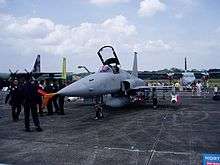
In addition, the starboard M39 20 mm cannon mounted in the nose was removed to make way for additional avionics (the sole cannon on the two-seaters was removed because of this), and to improve maneuverability, upgraded aircraft received larger leading edge root extensions (LERX). The process began in March 1996 and was completed by 2001, receiving the new designation of F-5S/T. In 1998, the eight RF-5Es also received the upgrades (except for the radar) and were redesignated as RF-5S.[17] Each F-5S/T upgraded reportedly cost SGD$6 million.[96]
By end of 2009, the type had accumulated more than 170,000 hours of flight time in Singapore service with only two F-5Es being lost in separate accidents (in 1984 and 1991, respectively).[17] As of June 2011, only 141 and 144 Squadron are left operating the RF-5S and F-5S/T, as 149 Squadron has since formally transitioned to the McDonnell Douglas F-15SG Strike Eagles on 5 April 2010.[97] 144 Squadron, the last squadron operating F-5Es, disbanded in September 2015 after the F-5S was retired. The F-5 remains as a trainer in the RSAF.
Switzerland
The Swiss Air Force flies a total of 22 F-5E and four F-5F aircraft, down from a peak of 98 and 12 in 1981.[98] They were chosen chiefly because of their excellent performance, suitability for the unique Swiss Air Force mission, and their relatively low maintenance cost per flight hour.
It had been expected these aircraft would be replaced by the Saab JAS 39 Gripen, but in May 2014, a referendum the Swiss people decided against the purchase of the Gripens.[99]
For the foreseeable future, the Swiss Air Force will continue to fly its present F-5s. There are still plans by the Swiss Air Force and in the Swiss parliament to fly 18 F-5E and four F-5F models. This would also include the continued operation of the Patrouille Suisse, in F-5Es until 2018.[100]
Taiwan
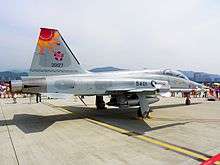
The Republic of China Air Force (ROCAF, Taiwan's air force) received its first batch of seven F-5As and two F-5Bs under the U.S. Military Assistance Program in 1965. By 1971, the ROCAF was operating 72 F-5As and 11 F-5Bs.[101] During 1972, the U.S. borrowed 48 ROCAF F-5As to lend to the Republic of Vietnam Air Force before the withdrawal of U.S. forces from Vietnam. By 1973, most of those loaned F-5As were not in flying condition, thus the U.S. opted to return 20 F-5As to Taiwan by drawing nine F-5As from U.S. reserves while repairing 11 from South Vietnam. An additional 28 new F-5Es were issued to Taiwan by May 1975.[102] By 1973, Taiwan's AIDC started local production of a first batch of 100 F-5Es, the first of six Peace Tiger production batches. By end of 1986 when the production line closed after completing Peace Tiger 6, the AIDC had produced 242 F-5Es and 66 F-5Fs. Taiwan was the largest operator of the type at one time, having 336 F-5E/Fs in inventory.[103] The last batch of AIDC F-5E/Fs featured the F-20's shark nose.[104]
With the introduction of 150 F-16s, 60 Mirage 2000-5s and 130 F-CK-1s in the mid-to-late-1990s, the F-5E/F series became second line fighters in ROCAF service and mostly are now withdrawn from service as squadrons converted to new fighters entering ROCAF service. Seven low airframe hours F-5Es were sent to ST Aerospace to convert them to RF-5E standard to fulfill a reconnaissance role previously undertaken by the retiring Lockheed RF-104G in ROCAF service.[105] As of 2009, only about 40 ROCAF F-5E/Fs still remain in service in training roles with about 90–100 F-5E/Fs held in reserve. The other retired F-5E/F are either scrapped, or used as decoys painted in colors representing the main front line F-16, Mirage 2000-5 or F-CK-1 fighters, and deployed around major air bases.[106]
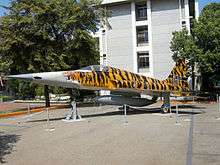
Taiwan also tried to upgrade the F-5E/F fleet with AIDC's Tiger 2000/2001 program. The first flight took place on 24 July 2002. The program would replace the F-5E/F's radar with F-CK-1's GD-53 radar and allow the fighter to carry a single TC-2 BVRAAM on the centerline. But lack of interest from the ROCAF eventually killed the program. The only prototype is on display in AIDC in Central Taiwan.[107][108]
The only air combat actions ROCAF F-5E/F pilots saw, were not over Taiwan, but in North Yemen. In 1979, a flareup between North Yemen and South Yemen prompted the U.S. to sell 14 F-5E/Fs to North Yemen to boost its air defense. Since no pilot in North Yemen knew how to fly the F-5E/F (only MiG-15s were operational at the time), U.S. and Saudi Arabia arranged to have 80+ ROCAF F-5E pilots,[109] ground crew, and anti-air defense units sent to North Yemen as part of North Yemen Air Force's 115th Squadron at Sana'a operating initially six F-5E/Fs. An additional eight aircraft were operated from April 1979 to May 1990. The ROCAF piloted F-5E/F scored a few kills in a few air battles, but the ground early warning radar crews and anti-air units also suffered from air attacks from South Yemen, whose aircraft were piloted by Soviet crews.[110] This operation is known as the Peace Bell Program in Saudi Arabia, and 大漠計畫 (literally the Great Desert Program) in Taiwan.
Vietnam
When South Vietnam was overrun by NVA forces on 30 April 1975, approximately 877 aircraft were captured by the communists. Of that number, 87 were reported as F-5As and 27 were F-5Es.[111] In November of that year the Soviets were offered the opportunity to select from the captured U.S. equipment. The Soviets quickly loaded one complete F-5, along with two complete spare engines, any and all spare parts, and all ground support equipment onto a waiting Soviet cargo ship.[112] Several of the F-5s left over from the Vietnam War were sent to Poland, Czechoslovakia,[4] and then Soviet Union, for advanced study of U.S. aviation technology, while others were decommissioned and put on display at museums in Vietnam. The 935th Fighter Regiment of the VPAF 372nd Air Division was the only unit in the world flying both MiG-21 and F-5 fighters. Eventually, the lack of spare parts grounded all the captured aircraft, but in May 2017 it was reported that Vietnam is considering refurbishing some of these aircraft and putting them back into service.[111]
Venezuela
After a reorganization of the Venezuelan Air Force in the late 1960s, the government realized that it was time to replace its obsolete de Havilland Vampires and Venoms active at that time, as well as the last surviving F-86 Sabres in active duty. In 1971, 54 Canadian-built CF-5As were put in storage, after the RCAF could not take them due to budget cuts. From this batch, Venezuela acquired 16 CF-5As and two CF-5Ds. In 1972, after all the aircraft were delivered, the F-86s, Venoms, and Vampires were finally scrapped.
The F-5 became the first military plane in Venezuela capable of flying at supersonic speeds. After a legal dispute between Canadair and Northrop, two more CF-5Ds were built and delivered to Venezuela in 1974. Their first base of operations was the General Rafael Urdaneta Air Base in Maracaibo. After 1974, the fleet was relocated to Teniente Vicente Landaeta Gil Air Base in Barquisimeto.
In 1979, after several upgrades to the fleet's communication, navigation and approximation equipment, the aircraft were renamed VF-5s, designating the CF-5As as VF-5As and the CF-5Ds as VF-5Ds. Venezuelan F-5s could also carry weaponry such as the AIM-9 Sidewinder missile, Mk.82 and M117 bombs, and 70mm rocket launchers.
In 1991, after tensions between Colombia and Venezuela almost led to a conflict, the air force started yet another modernization program for the F-5s, called "Proyecto Grifo" (Project Gryphon). Some aircraft (VF-5D number 5681 and VF-5A number 9124) were sent to Singapore for testing, then brought back for upgrade of the remaining airframes. That same year, a small fleet of four NF-5Bs and a single NF-5A, was acquired from the Netherlands to replace aircraft lost in previous years.
In 1992, during the coup d'état attempt against president Carlos Andres Perez, 3 F-5s were lost to a rebel-operated OV-10 Bronco bombing Barquisimeto Air Base. The failed coup delayed the modernization program for a year, finally coming together in 1993. The fleet was equipped with inertial laser navigation systems (similar to those in Venezuelan F-16s), IFFs, HUDs, refueling probes and modernized engines with an estimated lifespan of 22 years.
In 2002, small upgrades were made to the remaining F-5s. The fleet was kept operational until 2010, when a batch of Hongdu JL-8s was delivered as their replacement. By late 2010, it was known that at least one VF-5D was in flight-worthy condition; it is unknown if more aircraft are in operational condition.
Between 1972 and 2002, a total of 9 Venezuelan F-5s were lost.[113]
Others
Saudi Arabia deployed F-5Es during the Gulf War, flying close air support and aerial interdiction missions against Iraqi units in Kuwait. One Royal Saudi Air Force F-5E was lost to ground fire on 13 February 1991, the pilot killed.[114]
The Hellenic Air Force was the first European air force to receive the Freedom Fighter. The first F-5As were delivered in 1965, and over the next 8 years a total of about 70 F-5A/Bs were operational. The Hellenic Air Force bought an additional 10 F-5A/Bs from Iran in 1975, and around the same period another batch of 10 F-5A/Bs were acquired from Jordan. Another 10 were acquired from Norway in 1986, and a final 10 NF-5As were purchased from the Netherlands in 1991. The total number of F-5s in operation (including the ex-Iranian machines, 34 RF-5As, and 20 F-5Bs) in the Hellenic Air Force was about 120 aircraft, from 1965 to 2002, when the last F-5 was decommissioned and the type went out of operation in the Hellenic Air Force.[115]
AeroGroup, a private commercial company in the US, operates the CF-5B as a fighter lead-in aircraft for training and for other support services. There were 17 aircraft originally purchased from the Canadian Government with U.S. State Department approval and then imported into the US in 2006.[116][117][118]
Since 2013, Tunisian F-5s have been used in strike missions in support of major military offensives in the border region of Mount Chaambi against Ansar al-Sharia and al-Qaeda-linked militants.[119][120][121]
Variants
Single-seat versions

- N-156F
- Single-seat fighter prototype. Only three aircraft were built.
- YF-5A
- The three prototypes were given the U.S. Air Force designation YF-5A.
- F-5A
- Single-seat fighter version of F-5, originally without radar, but was later equipped with AN/APQ-153 radar during upgrades.
- F-5A (G)
- Single-seat fighter version of the F-5A for the Royal Norwegian Air Force.
- XF-5A
- Designation was given to one aircraft used for static tests.
- A.9
- Designation of Spanish Air Force Northrop F-5A which served in the Ejército del Aire.
- F-5C Skoshi Tiger
- Twelve F-5A Freedom Fighters were tested by the US Air Force for four and a half months in Vietnam.
- F-5E Tiger II
- Single-seat fighter version with AN/APQ-159 replacing earlier AN/APQ-153 in F-5A.
- F-5E Tiger III
- Upgraded version of the F-5E in use by the Chilean Air Force, with EL/M-2032 radar replacing the original AN/APQ-159 and capable of firing advanced versions of the Python missile
- F-5E/F
- A single Swiss Air Force F-5E with F-5F wings. As of 2011, this aircraft was part of the Museum at Meiringen air base
- F-5G
- The temporary designation given to the Northrop F-20 Tigershark, equipped with General Electric AN/APG-67 radar.
- F-5N
- Ex-Swiss Air Force F-5Es used by the U.S. Navy as an "aggressor" aircraft, with AN/APG-69 replacing the original AN/APQ-159. Intended to replace high-time USN/USMC F-5Es in the adversary role, and see service through to 2015.[6]
- F-5S
- Upgraded version of the F-5E in use by the Republic of Singapore Air Force, equipped with the Galileo Avionica's FIAR Grifo-F X-band radar and are capable of firing the AIM-120 AMRAAM.[17][34][35]
- F-5TH Super Tigris
- Formerly known as the F-5T Tigris before being officially redesignated. An upgraded version of the F-5E of Royal Thai Air Force by Israel, It is equipped with EL/M-2032, tactical datalink, Sky Shield jamming pod and are capable of firing the beyond visual range air-to-air Derby (missile).
- F-5EM
- Upgraded version of the F-5E of Brazilian Air Force equipped with Italian Grifo-F radar.
- F-5TIII
- Upgraded version of the F-5E, in service with the Royal Moroccan Air Force.
- F-5E Tiger 2000
- Upgraded version of Taiwan AIDC, equipped with the GD-53 radar, capable of firing the TC-2 Sky Sword II, MIL-STD-1553B Link and GPS/INS. Did not enter service as the ROCAF decided to immediately embark on the ultimately-successful process of acquiring additional F-16s to replace the F-5E/Fs altogether.
Reconnaissance versions
- RF-5A
- Single-seat reconnaissance version of the F-5A fighter. Approximately 120 were built.[122]
- RF-5A (G)
- Single-seat reconnaissance version of the F-5A fighter for the Royal Norwegian Air Force.
- RF-5E Tigereye
- Single-seat reconnaissance version of the F-5E fighter. The RF-5E Tigereye was exported to Saudi Arabia and Malaysia.
- RF-5E Tigergazer
- Seven upgraded single-seat reconnaissance version of the F-5E for Taiwan by ST Aerospace.[17]
- RF-5S Tigereye
- Single-seat reconnaissance version of the F-5S for the Republic of Singapore Air Force.[17]
- AR-9
- Spanish reconnaissance aircraft
- B.TKh.18
- Thai designation of the RF-5A
Two-seat versions

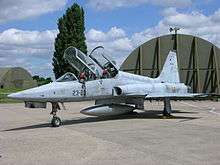
- AE.9
- Spanish designation of the Northrop F-5B.
- F-5-21
- Temporary designation given to the YF-5B.
- YF-5B
- One F-5B was fitted with a 5,000 lbf (2,268 kgf) General Electric J85-GE-21 engine, and used as a prototype for the F-5E Tiger II.
- F-5B
- Two-seat trainer version.
- F-5B(G)
- Two-seat trainer version of the F-5B for the Royal Norwegian Air Force.
- F-5BM
- Two-seat trainer version in use by the Spanish Air Force for air combat training.
- F-5D
- Unbuilt trainer version.
- F-5F Tiger II
- Two-seat trainer version of F-5E Tiger II, AN/APQ-167 radar tested, intended to replace AN/APQ-157, but not carried out.
- F-5F Tiger III
- Upgraded trainer version of the F-5F in use by the Chilean Air Force.
- F-5T
- Upgraded F-5F in use by the Republic of Singapore Air Force.[17]
- F-5THF (บ.ข.18 ค)[123]
- Twin-seat version of F-5TH currently in active services with the Royal Thai Air Force as of May 2020.
- F-5FM
- Upgraded trainer version of the F-5F for the Brazilian Air Force.
Foreign variants

Licensed versions
- CF-5
- Fighter versions for the Canadian Forces Air Command built under license by Canadair. Its Canadian designation is CF-116.
- NF-5A
- Single-seat fighter version of the CF-5A for the Royal Netherlands Air Force; 75 built.
- NF-5B
- Two-seat training version of the CF-5D for the Royal Netherlands Air Force; 30 built.
- SF-5A
- Single-seat fighter version of the F-5A for the Spanish Air Force; built under licence in Spain by CASA.
- SRF-5A
- Single-seat reconnaissance version of the RF-5A for the Spanish Air Force; built under license in Spain By CASA.
- SF-5B
- Two-seat training version of the F-5B for the Spanish Air Force. Built under license by CASA in Spain.
- VF-5A
- Single-seat version of the CF-5A for the Venezuelan Air Force. This designation was given to some Canadair CF-116s which were sold to the Venezuelan Air Force.
- VF-5D
- Two-seat training version of the CF-5D for the Venezuelan Air Force.
- KF-5E
- F-5E built in South Korea for the Republic of Korea Air Force. First introduction: September 1982; 48 built.
- KF-5F
- F-5F built in South Korea for the Republic of Korea Air Force. First introduction: September 1982; 20 built.
- Chung Cheng
- F-5E/F built in Taiwan for Republic of China Air Force by AIDC. First introduction: 30 October 1974, one day before President Chiang Kai Shek's 88th birthday, and was thus christened "Chung Cheng", an alias of President Chiang; 308 built.
Unlicensed versions
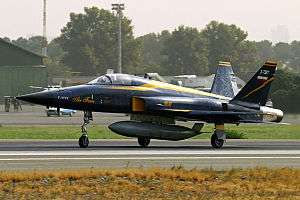
Derivatives
F-20 Tigershark
In comparison to later fighters, the improved F-5E had some weaknesses; these included marginal acceleration, rearward visibility, and fuel fraction, and a lack of Beyond Visual Range (BVR) weapons once such radar guided missiles became reliable during the 1980s.[125] The F-5G, later renamed the F-20 Tigershark, aimed to correct these weaknesses while maintaining a small size and low cost to produce a competitive fighter. Compared to the F-5E, it had 60% more power, a higher climb rate and acceleration, better cockpit visibility, more modern radar and BVR capability, and competitive performance with fourth generation fighters. Like the F-5, it had better cost effectiveness as it had the minimum necessary features relative to its competition to perform its air superiority mission. As an example, in the 1960s and early 1970s, the F-5's lack of BVR missiles was not a significant disadvantage as the kill rate of such missiles was approximately 8% to 10%,[126] and the performance and loss of surprise (radar warning to the enemy) cost of carrying them was not practically justified. By the early 1980s, the American AIM-7 Sparrow radar-guided missile in its "M" version was realistically exceeding a 60% kill rate, and was integrated onto the F-20. Brigadier General Chuck Yeager, test pilot and the first man to break the sound barrier, referred to the F-20 as "the finest fighter".[127] Despite its performance and cost effectiveness, the F-20 lost out for foreign sales against the similarly capable, more expensive F-16, which was being procured in large numbers by the U.S. Air Force and was viewed as having greater support.[128]
Northrop YF-17
The Northrop YF-17's main design elements date from the F-5 based internal Northrop project N-300. The N-300 featured a longer fuselage, small leading-edge root extensions (LERX), and more powerful GE15-J1A1 turbojets. The wing was moved higher on the fuselage to increase ordnance flexibility. The N-300 further evolved into the P-530 Cobra. The P-530's wing planform and nose section was similar to the F-5, with a trapezoidal shape formed by a sweep of 20° at the quarter-chord line, and an unswept trailing edge, but was over double the area. While the YF-17 lost its bid for the USAF lightweight fighter, it would be developed into the larger McDonnell Douglas F/A-18 Hornet.
Shaped Sonic Boom Demonstration
A single ex-USN F-5E was modified to carry out research into reducing noise from supersonic flight by shaping the shock waves produced by the aircraft.
Operators

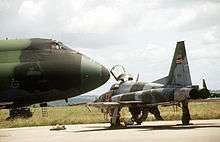
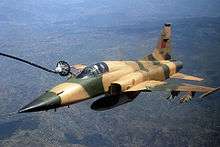
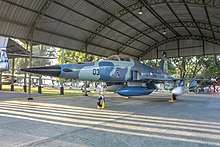
.jpg)
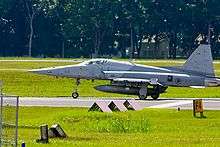
_arrives_RIAT_Fairford_10thJuly2014_arp.jpg)
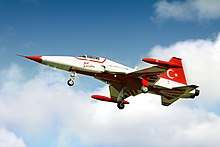
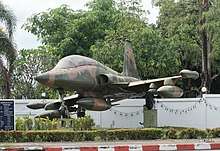
- Austrian Air Force: On loan from Switzerland – all aircraft returned and replaced by Eurofighter Typhoons.
- Bahrain Air Force received eight F-5Es and two F-5Fs in between 1985 and 1987.[129]
- Botswana Air Force purchased 10 upgraded CF-5As and 3 CF-5Ds from Canada in 1996.[130] A further two CF-5Ds were purchased in 2000.[131]
- Brazilian Air Force purchased 78 F-5's of different variants from 1974. Operates 43 F-5EM and 4 F-5FM as of 2020,[132] to be withdrawn gradually between 2017 and 2030,[133][134] replaced by the JAS 39E/F Gripen.[135]
- Canadian Forces – see Canadair CF-5
- Chilean Air Force: Chile purchased 15 F-5Es and 3 F-5Fs in the 1970s, these being upgraded to Tiger III standard from 1993.[136][137] A total of 10 F-5s remain operational as of 2009.[138] In March 2013, the Uruguayan Air Force initiated talks for procuring 12 surplus F-5 Tiger III aircraft from Chile for $80 million.[139] However, the potential sale of the aircraft has come to naught and 11 aircraft continue to be operated by the Chilean Air Force, based in Punta Arenas.
- Ethiopian Air Force first delivery in 1966; it has operated the A, B, and E variants.
- Hellenic Air Force received the first 55 F-5As in 1965. In 1975, 10 aircraft were bought from Iran and later, another 10 followed from Jordan. In 1986, nine aircraft were granted from Norway and in 1991, 10 NF-5As were granted by the Netherlands. During 1967 and 1968 this type of aircraft was used by the 3rd Hellenic Aerobatic Team "New Hellenic Flame". The last NF-5As were retired in 2002.[140]
- Honduran Air Force: The United States delivered 10 F-5E and 2 F-5Fs starting in 1987 as replacements of Dassault Super Mystére, which were reassigned to airstrike as they were in their last years of service. The F-5 were refurbished former United States Air Force aircraft.
- Indonesian Air Force: Upgraded in Belgium in the middle to late 1990s. All 16 F-5E/Fs have been retired since 3 May 2016 per directive from Chief of Indonesian Air Force due to safety issue.[141]
- Islamic Republic of Iran Air Force: 60 to 75 F-5E and F operational; Iran originally had received a total of 127 F-5A/B by 1972 which soon began to be phased out/sold to other countries. Simultaneously by 1976 Iran had received a total of 181 of the improved F-5E/F/RF-A delivered to the Imperial Iranian Air Force.
- Unknown numbers of HESA Saeqeh and HESA Azarakhsh fighters derived from the F-5 design.
- Royal Jordanian Air Force – retired 2015. Replaced by F-16A/B and Hawk Mk 63. Sold 11 to Brazil for $21 million in 2009.[142]
- Kenya Air Force: In July 2008, it was reported that Kenya will spend 1.5 billion KSh to buy 15 former Jordanian Air Force F-5s, 13 F-5E and two F-5F upgraded with Rockwell Collins avionics[143] (plus training and spare parts). They will be added or eventually replace the existing F-5 fleet.[144]
- Republic of Korea Air Force: Received a total of 340 F-5s (88 F-5A, 30 F-5B, 8 RF-5A, 126 F-5E, 20 F-5F, 48 KF-5E, and 20 KF-5F). During the Vietnam War, 36 F-5As and 8 RF-5As were transferred to the Republic of Vietnam Air Force in exchange of F-4 Phantom II from the United States Air Force. 5 RF-5As were brought back to Korea before the war ended. The last Freedom Fighter retired in 2005, and 8 F-5As were donated to the Philippines Air Force. The ROKAF plans to replace the U.S. made F-5E/Fs with 60 new FA-50 aircraft.
- Royal Libyan Air Force to 1969. 10 F-5s. May have been sold to Turkey after 1969.
- Mexican Air Force received 12 F-5s in 1982. They operated eight F-5Es and two F-5F until being retired in 2017.[145] In 2019 three Mexican F-5Es and one F-5F were seen flying; they are being repaired to put back into service.
- Royal Moroccan Air Force operates 12 F-5A/Bs upgraded with Tiger II avionics and 24 upgraded F-5 Tiger III.[146]
- Royal Malaysian Air Force uses 4 F-5F as trainer aircraft while another 16 of its Northrop F-5E Tiger IIs were upgraded for reconnaissance purposes.[147]
- Royal Netherlands Air Force (former operator), received 75 Canadair built NF-5A (Single-seat fighter version) and 30 NF-5B (two-seat training version) between 7 October 1969 and 20 March 1972.[148] After the aircraft were phased out and replaced by the modern F-16 Fighting Falcon, the aircraft were initially stored at Gilze-Rijen Air Base and Woensdrecht Air Base, until finally 60 aircraft were sold to Turkey, 11 to Greece and 7 to Venezuela.[148] Several of the remaining aircraft can be found in aviation museums and technical schools.
- No. 313 Squadron; Twente Air Base. Formed September 1972, transitioned to F-16 in 1987.[149]
- No. 314 Squadron; Eindhoven Air Base. Converted from F-84F from June 1970, and was fully equipped in November that year. The squadron transitioned to the F-16 in April 1990.[149]
- No. 315 Squadron, Operation Conversion Unit (OCU); Twente Air Base (transitioned to F-16 in 1986)
- No. 316 Squadron; Gilze-Rijen Air Base (transitioned to F-16 in 1991)
- Field Technic Training Unit NF-5 (1971–1984); Twente Air Base
- Royal Norwegian Air Force (former operator)
- Philippine Air Force received 19 F-5A (single seat) and three F-5B (two seat) aircraft in 1965–1967. In 1989, the PAF received three ex-Taiwanese F-5A and one F-5B.[150] In the 1990s, at least eight ex-South Korean F-5A and two Jordanian F-5A were acquired. The Philippines decommissioned its F-5A/B fleet in 2005.[93]
- Royal Saudi Air Force: From 1974 to 1985 received a total of 20 F-5Bs, 109 F-5E/Fs and 10 RF-5Es.[151][152]
- Republic of Singapore Air Force: operates 32 F-5S, 9 F-5T and 8 RF-5S fighters in 2011.[17] Mostly retired with a few left for training in 2014,[153] before retiring all in 2015. (former operator)[154]
- Republic of Vietnam Air Force received a fleet of 158 former U.S., South Korean, Iranian, and Taiwanese F-5A Freedom Fighters, 10 RF-5A and eight F-5B trainers, USA also provided newer F-5E Tiger IIs, most of F-5s were evacuated to Thailand in 1975, but many were captured by People's Army.
- Spanish Air Force, operates 19 F-5BM as trainers for fighter school. Initially, 70 fighters version A and B were delivered.[155]
- Sudanese Air Force: 10 F-5Es and two F-5F were delivered in 1978, One of the F-5Fs was sold to Jordan. further two F-5s defected to Sudan from Ethiopia during the Ogaden crisis.[29]
- Swiss Air Force: Operating 42 F-5E and 12 F-5F Tiger II.[156] The Swiss chose the F-5 because it was simpler to maintain than the F-16.[157]
- Republic of China Air Force: Received 115 F-5A and B from 1965, 48 were transferred to South Vietnam before 1975. From 1973 to 1986, Taiwan produced 308 F-5E/Fs under license.[31] Later batches of locally AIDC licensed production of Tiger IIs were fitted with flare/chaff dispensers, plus handling qualities upgrades with enlarged LEX and F-20's shark nose, and radar warning receivers(RWR).[104][158]
- Royal Thai Air Force: 30 F-5A/B/C retired. Now operating about 40 F-5E/F/T, F-5s from 701st Sq. retired and replaced by 12 JAS 39 Gripens. The last F-5 fleet, upgraded into F-5TH and F-5THF in 211st Sq. continue to serve until 2025–2030.
- Tunisian Air Force: Eight F-5E and four F-5F Tiger II were delivered in 1984–1985. The TAF received five ex-USAF F-5E in 1989. A total of 16 aircraft still in service.
- Turkish Air Force: More than 200 F-5A/Bs and NF-5A/Bs were bought from various countries. Between 40 and 50 of them were upgraded to F-5/2000 standard during the 2000s (decade). The F-5/2000 remains active of which 10 F-5A and two F-5Bs belong to the Turkish Stars aerobatic display team.[159]
- F-5Es were received from Vietnam and the Derg regime in Ethiopia for performance tests and evaluation flights. They were tested in mock combat against MiG-21 and MiG-23 aircraft, ultimately aiding in the development of the MiG-23MLD and the MiG-29.[160][161]
- United States Air Force
- Continental United States-based units
- 64th Aggressor Squadron (1976–1988) Nellis Air Force Base, Nevada
- 65th Aggressor Squadron (1975–1989) Nellis Air Force Base, Nevada
- United States Air Forces Europe (USAFE)
- 527th Aggressor Squadron (1976-1988) RAF Alconbury, England
- Pacific Air Forces (PACAF)
- 26th Aggressor Squadron (1977-1988) Clark Air Base, The Philippines
- Continental United States-based units
- United States Navy
- United States Marine Corps
- Venezuelan Air Force 27 aircraft acquired (16 CF-5As, 4 CF-5Ds, 1 NF-5A, 6 NF-5Bs), 9 lost to accidents, all surviving aircraft were retired.[162]
- Vietnam People's Air Force (several captured ex-RVNAF aircraft). One F-5E (s/n 73-00867) was transferred to the Soviet Union for evaluation flights, i.e. against the MiG-21bis; 40+ F-5E/F/C were in VNAF's service.[163] After the Vietnam War, Vietnamese forces used the captured F-5 fleet against Chinese forces during Sino-Vietnamese War.
- Yemen Air Force: North Yemen Air Force's 14 F-5E/F fleet were initially piloted by ROCAF/Taiwan pilots as part of 115th Squadron at Sana'a, from April 1979 to May 1990, to boost its air defense.
Aircraft on display
Brazil
- F-5B
- FAB-4805 - Brazilian Air Force - Santa Cruz Air Force Base, Rio de Janeiro[164]
- F-5E
- FAB-4879 - Brazilian Air Force - CINDACTA II, Curitiba[165]
Greece
- F-5A
- 68-9071 – Athens War Museum[167]
- 69–132 – Hellenic Air Force Museum[168]
- 13-353 – Thessaloniki War Museum[169]
- RF-5A
- 69-7170 – Hellenic Air Force Museum[170]
Indonesia
- F5-E
- TS-0503 - Dirgantara Mandala Museum, Yogyakarta, Indonesia[171]
- TS-0510 - In front of Indonesian National Air Defense Forces Command, Halim Perdanakusuma International Airport, Jakarta, Indonesia[171]
Norway
- F-5A
- 69-7134 -- Norwegian Aviation Museum[172]
- 68-9102 -- Norwegian Aviation Museum[172]
- AH-M -- Sola Aviation Museum[173]
- 594 -- Norwegian Armed Forces Aircraft Collection[174]
Philippines
- F-5A
- 64-13326 - Philippine Air Force Museum, Pasay
- 65-10499/FA-499 - Basa Air Base, Pampanga
- 65-10507 - Clark Air Base, Pampanga
- F-5B
- 40780 - Clark Air Base, Pampanga. Ex-RoCAF "1117"
Switzerland
- F-5E
- J-3096 Gate Guard as "J-3013" in Patrouille Suisse paint at the Flieger-Flab-Museum
- J-3098 at the Flieger-Flab-Museum
- J-3099 Gate Guard as "J-3008" at Meiringen Air Base
- F-5F
- J-3202 at the Flieger-Flab-Museum[177]
Thailand

- F-5A
- 97158 - Royal Thai Air Force Museum
- F-5B
- 38438 - Royal Thai Air Force Museum, the first F-5 from the production line
- 01603 - Wing 23 gate Udon Thani International Airport
Turkey
- F-5A
- 14460 – Istanbul Aviation Museum[178]
- NF-5A
- 3022/22 – Istanbul Aviation Museum[178]
- 3070/3-070 – Istanbul Aviation Museum[178]
- RF-5A
- 97147/5-147 – Istanbul Aviation Museum[178]
United States
- YF-5A
- 59-4987 – Museum of Flight at Boeing Field in Seattle, Washington[179]
- 59-4989 – National Museum of the United States Air Force at Wright-Patterson AFB near Dayton, Ohio[180]
- F-5A
- 66-9207 – Western Museum of Flight in Torrance, California[181][182]
- F-5B
- 63-8447 - Phillip and Patricia Frost Museum of Science, Miami, Florida. Formerly on display at Octave Chanute Aerospace Museum at the former Chanute AFB, Rantoul, Illinois.[183][184] Currently displayed completely covered in chrome.[185]
- 72-0441 – Pima Air and Space Museum, adjacent to Davis-Monthan AFB in Tucson, Arizona[186]
- F-5E
- 72-1387 – Pacific Coast Air Museum, Santa Rosa, California[187]
- 74-1558, later US Navy 741558 – Fort Worth Aviation Museum, Fort Worth, Texas[188]
- 74-1564, later US Navy/US Marine Corps 741564 – Flying Leatherneck Aviation Museum at MCAS Miramar in San Diego, California[189]
- 74-1571 – Nellis Air Force Base, Las Vegas, Nevada[190] Carries the markings of the 57th Fighter Weapons Wing, with Bort Code 65.
Specifications (F-5E Tiger II)


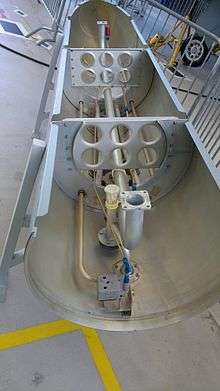
Data from Jane's all the World's Aircraft 1976–77,[192] The Complete Book of Fighters,[193] Quest for Performance[194]
General characteristics
- Crew: 1
- Length: 48 ft 2.25 in (14.6876 m)
- Wingspan: 26 ft 8 in (8.13 m)
- 27 ft 11.875 in (8.53123 m) with wing-tip missiles
- Height: 13 ft 4.5 in (4.077 m)
- Wing area: 186 sq ft (17.3 m2)
- Aspect ratio: 3.86
- Airfoil: NACA 65A004.8[195]
- Empty weight: 9,583 lb (4,347 kg)
- Gross weight: 15,745 lb (7,142 kg) clean
- Max takeoff weight: 24,675 lb (11,192 kg)
- Fuel capacity:
- Internal fuel: 677 US gal (564 imp gal; 2,560 l)
- External fuel: up to 3x 275 US gal (229 imp gal; 1,040 l) drop-tanks
- Lift-to-drag ratio: 10.0
- Zero-lift drag coefficient: CD0.0200
- Frontal area: 3.4 sq ft (0.32 m2)
- Powerplant: 2 × General Electric J85-GE-21 afterburning turbojet engines, 3,500 lbf (16 kN) thrust each dry, 5,000 lbf (22 kN) with afterburner
Performance
- Maximum speed: Mach 1.63 (1,740 km/h; 1,080 mph) at 36,000 ft (11,000 m)
- Maximum cruise speed: Mach 0.98 (1,050 km/h; 650 mph) at 36,000 ft (11,000 m)
- Economical cruise speed: Mach 0.8 (850 km/h; 530 mph) at 36,000 ft (11,000 m)
- Stall speed: 124 kn (143 mph, 230 km/h) 50% internal fuel, flaps and wheels extended
- Never exceed speed: 710 kn (820 mph, 1,310 km/h) IAS
- Range: 481 nmi (554 mi, 891 km) clean
- Combat radius (20 min reserve): 120 nmi (140 mi; 220 km) with 2x Sidewinders + 5,200 lb (2,400 kg) ordnance, with 5 minutes combat at max power at sea level
- Ferry range: 2,010 nmi (2,310 mi, 3,720 km) [196]
- Ferry range (20 min reserve): 1,385 nmi (1,594 mi; 2,565 km) drop tanks retained
- Ferry range (20 min reserve): 1,590 nmi (1,830 mi; 2,940 km) drop tanks jettisoned
- Service ceiling: 51,800 ft (15,800 m)
- Service ceiling one engine out: 41,000 ft (12,000 m)
- Rate of climb: 34,500 ft/min (175 m/s)
- Lift-to-drag: 10:1
- Wing loading: 133 lb/sq ft (650 kg/m2) maximum
- Thrust/weight: 0.4 take-off thrust at maximum take-off weight
- Take-off run: 2,000 ft (610 m) with two Sidewinders at 15,745 lb (7,142 kg)
- Take-off run to 50 ft (15 m): 2,900 ft (884 m) with two Sidewinders at 15,745 lb (7,142 kg)
- Landing run from 50 ft (15 m): 3,701 ft (1,128 m) without brake-chute
- Landing run from 50 ft (15 m): 2,500 ft (762 m) with brake-chute
Armament
- Guns: 2× 20 mm (0.787 in) M39A2 Revolver cannon in the nose, 280 rounds/gun
- Hardpoints: 7 total (only pylon stations 3, 4 and 5 are wet-plumbed): 2× wing-tip AAM launch rails, 4× under-wing & 1× under-fuselage pylon stations with a capacity of 7,000 pounds (3,200 kg),with provisions to carry combinations of:
- Rockets:
- Missiles:
- 2× AIM-9 Sidewinder air-to-air missile on wingtips (initial F-5E Tiger II loadout)[197]
- 4× AIM-9 Sidewinder or 4× AIM-120 AMRAAM[198] air-to-air missile (F-5S and modernized F-5E)
- 4× AGM-65 Maverick air-to-surface missiles (on upgraded F-5)[199]
- AA-8 Aphid, AA-10 Alamo, AA-11 Archer and other Russian/Chinese AAMs (Iranian ver.)
- Bombs: A variety of air-to-ground ordnance such as the Mark 80 series of unguided bombs (including 3 kg and 14 kg practice bombs), CBU-24/49/52/58 cluster bomb munitions, napalm bomb canisters and M129 Leaflet bomb, and laser-guided bombs of Paveway family.
- Other:
- up to 3× 150/275 U.S. gallon Sargent Fletcher drop tanks for ferry flight or extended range/loitering time.
- 2× GPU-5/A 30mm cannon pods (fitted only on Thai F-5s)
- Rockets:
Avionics
- Emerson Electric AN/APQ-153 radar on early batch of F-5E[200]
- Emerson Electric AN/APQ-159 radar on later production F-5E[200]
- Emerson Electric AN/APQ-157 radar on F-5F[201]
- Emerson Electric AN/APG-69 radar on US Navy F-5N (ex-Swiss Air Force F-5E) aggressors role[202]
- Leonardo S.p.A. Grifo-F radar on Singaporean Air Force upgraded F-5E[202]
- AN/AVQ-27 Laser Target Designator Set (LTDS), for F-5B and F-5F only.[203]
Notable appearances in media
See also
Related development
- Northrop T-38 Talon
- Canadair CF-5
- HESA Azarakhsh
- HESA Saeqeh
- HESA Kowsar
- Northrop F-20 Tigershark
- Northrop YF-17
- Shaped Sonic Boom Demonstration
Aircraft of comparable role, configuration and era
- Aeritalia G.91
- Dassault Mirage F1
- Mikoyan-Gurevich MiG-21
Related lists
References
Notes
- The 492 F-5s in service as of December 2013 made it the eighth most common active fighter and attack jet, comprising about three percent of the world's tactical jet warplanes.[7]
Citations
- "Northrop F-5 Freedom Fight." Archived 12 October 2012 at the Wayback Machine National Museum of the United States Air Force. Retrieved: 14 November 2012.
- Johnsen 2006, p. 90.
- Knaack 1978, p. 290.
- Baugher, Joseph ‘Joe’. "Northrop F-5E/F Tiger II in Service with Vietnam". Archived from the original on 22 December 2015. Retrieved 17 December 2015.
- "Military Aircraft Update: Northrop F-5/T-38. Aviation Week & Space Technology (Aviation Week Intelligence Network), Vol. 175, Issue 39, 21 November 2013, p. 89.
- "F-5N/F Adversary aircraft fact file." Archived 7 March 2008 at the Wayback Machine U.S. Navy. Retrieved: 15 May 2010.
- Hoyle, Craig. "World Air Forces 2014." Archived 25 December 2013 at the Wayback Machine Flightglobal, p. 5. Retrieved: 3 September 2014.
- Garrison, Peter. "White Rocket", Air and Space Magazine, September 2005.
- Wagner 2000, p. 195. Chapter 9 of this book is devoted to the F-5.
- Stuart, William G., "Northrop F-5 Case Study in Aircraft Design", 1978, pp. 5–7. Reprints are available from on-line sources.
- "Era of the F-5 Ends After Three Decades", Los Angelos Times, 16 Jan. 1987, available at https://www.latimes.com/archives/la-xpm-1987-01-16-fi-3612-story.html.
- Wagner 2000, p. 197.
- Braybrook 1982, pp. 111–114.
- Stuart 1978, p. 21.
- Garrison, 2005.
- Stuart, 1978, p. 7.
- Yeo, Mike. "Tigers over Lion City." AirForces Monthly (Key Publishing), Issue 275, March 2011, pp. 86–91. ISSN 0955-7091. Retrieved: 8 June 2011.
- Paloque 2013, pp. 4–7.
- Lake and Hewson 1996, pp. 50–51.
- Braybrook 1982, p. 114.
- Lake and Hewson 1996, p. 51.
- Harding 1990, pp. 118–119, 122–123, 188–189.
- Lake and Hewson 1996, pp. 52–53.
- Lake and Hewson 1996, pp. 82–83.
- Lake and Hewson 1996, pp. 58–59, 70–71.
- Braybrook 1982, p. 116.
- Lake and Hewson 1996, pp. 71–72.
- "F-5E/F Tiger II". GlobalSecurity.org. Archived from the original on 25 March 2016. Retrieved 29 January 2016.
- Lake and Hewson 1996, p. 103.
- Lake and Hewson 1996, p. 96.
- Lake and Hewson 1996, p. 104.
- Tambini, Anthony, "F-5 Tigers over Vietnam", 2014, ISBN 9780828320597.
- "F-5 Tiger II". Touchdown Aviation. Archived from the original on 7 September 2016. Retrieved 29 January 2016.
- "Press release: Assets: Fighter aircraft." Archived 2 February 2014 at the Wayback Machine Ministry of Defence (Singapore), 24 April 2010. Retrieved: 8 June 2011.
- "Brazil favours Grifo F radar for F-5BR upgrade". Flightglobal.com, 11 April 2000. Retrieved: 8 June 2011.
- "F5E-Modified." Archived 12 February 2012 at the Wayback Machine vacwarbirds.org. Retrieved: 24 April 2012.
- "Thailand's Latest F-5 Upgrade Features Israeli Kit".
- "Bombas Guiada SMKB." Revista Asas(Portuguese), Volume 61, June 2011, p. 29. ISSN 1413-1218.
- "Denel's A-Darter makes test debut" Archived 21 May 2013 at the Wayback Machine Flight Global, 26 February 2009. Retrieved: 28 January 2012.
- "FAB comemora dia da Aviação de Caça!" (in Portuguese). Archived 19 September 2008 at the Wayback Machine alide.com.br. Retrieved: 28 January 2012.
- "F-5EM com míssil Python IV" (in Portuguese). Archived 25 December 2011 at the Wayback Machine Poder Aéreo, 4 November 2010. Retrieved: 28 January 2012.
- "As garras afiadas do F-5EM" (in Porguguse). Archived 16 February 2012 at the Wayback Machine Poder Aéreo, 24 August 2008. Retrieved: 28 January 2012.
- Lake and Hewson 1996, p. 53.
- Plunkett, W. Howard. "When the Thunderbirds Flew the Thunderchief." Air Power History, Air Force Historical Foundation, Clinton, Maryland, Fall 2009, Volume 56, Number 3, pp. 24–25.
- Thompson 1996, pp. 4–6.
- Hobson p. 43, 64, 70, 71, 73, 75, 83, 90, 268
- Thompson 1996, pp. 12, 14.
- Thompson 1996, p. 16.
- Toperczer No. 29 pp. 80, 81.
- "Photo of a Northrop F-5E Tiger II in Kraków, Poland a gift of the Democratic Republic of Vietnam." Archived 29 March 2013 at the Wayback Machine muzeumlotnictwa.pl. Retrieved: 15 May 2010.
- Gervasi, Arsenal of Democracy II, p. 123
- Auten, Roger Ball! p. 390
- Gillcrist, TOMCAT! p.95
- Lake (Ed.), F-14 Shipborne Superfighter, p.85
- Sprey 1972, p. 140.
- "Northrop F-5 Freedom Fighter." Archived 4 March 2014 at the Wayback Machine Great Planes episode, Discovery Channel, May 2012.
- Ted, Carlson. "One-Eleven Heaven" AirForces Monthly (Key Publishing), Issue 283, October 2011, p. 48. ISSN 0955-7091. Retrieved: 10 October 2011.
- "FAA Registry: Northrop F-5." Archived 18 August 2012 at the Wayback Machine FAA. Retrieved: 17 May 2011.
- "FAA Registry: Canadair F-5." Archived 18 August 2012 at the Wayback Machine FAA. Retrieved: 17 May 2011.
- "Os primeiros F-5 da FAB" [The Brazilian air force's first F-5s], Poder Aéreo (in Portuguese), 1 July 2011, archived from the original on 26 July 2012, retrieved 26 January 2012.
- Poggio, Guilherme (11 August 2011), "39 anos do voo do primeiro F-5E… e ele continua na ativa!" [39 years of the first F-5 flight… and it continues active!], Poder Aéreo (in Portuguese), archived from the original on 12 September 2011, retrieved 28 December 2011.
- "PAMA-SP 2011: um F-5B com roupa de 'Mike'" [PAMA-SP 2011: an F-5B dressed as a 'Mike'], Poder Aéreo (in Portuguese), 7 November 2011, archived from the original on 4 November 2012, retrieved 27 December 2012.
- "F-5A Freedom Fighter" Archived 9 February 2012 at the Wayback Machine. Deagel. Retrieved: 28 December 2011.
- "F-5 Brazil." Archived 4 February 2014 at the Wayback Machine wikinvest, 28 May 2008. Retrieved: 29 December 2011.
- "FAB compra Pod Litening III" (in Portuguese). Archived 6 May 2012 at the Wayback Machine Alide. Retrieved: 26 January 2012.
- "Diario Oficial da União" (in Portuguese). Archived 21 May 2013 at the Wayback Machine scribd.com. Retrieved: 26 January 2012.
- "Os F-5 da Jordânia, agora na FAB" (in Portuguese). Archived 23 May 2012 at the Wayback Machine Poder Aéreo, 29 October 2009. Retrieved: 28 December 2011.
- "Aeronáutica reforma 11 caças por R$ 276 mi" (in Portuguese). Archived 24 October 2011 at the Wayback Machine Agencia T1, 18 April 2011. Retrieved: 29 December 2011.
- "Embraer Defense and Security to modernize 11 additional F-5 jet fighters for the Brazilian Air Force." Archived 5 April 2013 at the Wayback Machine Deagel, 14 April 2011. Retrieved: 29 December 2011.
- Cooper, Tom. "Ethiopia and Eritrea, 1950–1991." Archived 11 March 2012 at the Wayback Machine acig.org, 10 February 2008. Retrieved: 1 July 2011.
- Ogaden War (Ethiopian-Somalia Conflict) 1977-1978
- Cooper, Tom., "Wings over Ogaden, 2015, ch. 3
- Cooper, Tom & Fontanellaz, Adrian, "Ethiopian-Eritrean Wars Volume 1, 2018, ch. 4
- Which is Better, the F-5E Tiger II or the MiG-21? by Tom Cooper
- Ethiopia : Hero Air Force General Passes Away
- Air Force hero General Tefera Legese dies in Washington, DC
- Ogaden War (Ethiopian-Somalia Conflict) 1977-1978
- Isayev, Jafarov, S., T. (23 February 2012). "Iran now capable of overhauling and modifying F-5 Freedom fighter jet". Trend News Agency. Archived from the original on 4 February 2016. Retrieved 29 January 2016.
- "The first air force to receive F-5E was the Imperial Iranian Air Force." Archived 24 September 2015 at the Wayback Machine iiaf.net. Retrieved: 6 June 2010.
- IRIAF Archived 1 February 2009 at the Wayback Machine. iiaf.net. Retrieved: 6 June 2010.
- "Arabian Peninsula & Persian Gulf Database: Iranian Air-to-Air Victories, 1982." Archived 23 March 2010 at the Wayback Machine acig.org, 16 September 2003. Retrieved: 15 May 2010.
- Jakubovich, Nickolai (2012). "Neizvestnii MiG. Gordost sovetskogo aviaproma"/Razvedchiki/bombardirovshiki. Eksmo. (Russian:"Неизвестный «МиГ». Гордость советского авиапрома"/Разведчии/бомбардировщики, Николай Якубович, 2012)
- "Iraqi Air Force Equipment – Introduction." Archived 16 August 2008 at the Wayback Machine globalsecurity.org. Retrieved: 6 June 2010.
- "Why Iran's Fighter-Jet Ripoff Is Just Fake News". 18 February 2017. Archived from the original on 22 May 2018.
- Axe, David. "Kenyan Jets Spearhead Somalia Operation." Archived 4 January 2012 at the Wayback Machine offiziere.ch, 1 November 2011. Retrieved: 24 April 2012.
- "Mexico seeks to maintain F-5 fighter fleet". IHS Jane's Defence Weekly. Erwan de Cherisey, Paris. 23 September 2016. Archived from the original on 22 November 2016. Retrieved 8 October 2016.
- Cooper, Tom. "Morocco, Mauritania & West Sahara since 1972". ACIG.org. Archived from the original on 4 March 2016. Retrieved 1 January 2016.
- "Morocco." Archived 20 August 2009 at the Wayback Machine century-of-flight.net, 2003. Retrieved: 15 May 2010.
- "Archived copy". Archived from the original on 11 October 2018. Retrieved 11 October 2018.CS1 maint: archived copy as title (link)
- Hafsten, Bjørn. "Northrop F-5 i norsk tjeneste" (Northrop F-5 in Norwegian Service) (In Norwegian). Warbirds of Norway Newsletter, 2009.
- Dalløkken, Per Erlien (25 October 2011). "F-5 blir gitt bort". Teknisk Ukeblad (in Norwegian). Retrieved 2 May 2017.
- "PAF to retire F-5 fleet". Philippine Star, 29 September 2005. Retrieved: 8 April 2009.
- Evangelista, Kate. "Philippine Air Force to buy 6 fighter jets." Archived 2 September 2011 at the Wayback Machine Globalnation via inquirer.net, 1 July 2011. Retrieved: 11 October 2011.
- Wilson 2002, p. 180.
- "Singapore F-5 upgrade to go ahead." FlightGlobal.com, 13 March 1996. Retrieved: 28 June 2011.
- Boey, David. "Meet Bitching Betty – She sits in a plane, one of 40 F-5S aircraft which have been upgraded at about $6 million a plane."The Straits Times (Singapore Press Holdings), 4 April 1999, p. 23. Retrieved: 22 March 2012.
- "Press release: Inauguration of the RSAF's First Local F-15SG Squadron." Archived 24 December 2014 at the Wayback Machine MINDEF, 5 April 2010. Retrieved: 8 June 2011.
- "Northrop F-5E Tiger II". Swiss Air Force. April 2015. Archived from the original on 28 July 2016. Retrieved 9 June 2016.
- de Larrinaga, Nicholas. "Swiss voters reject Gripen purchase." Archived 27 July 2014 at the Wayback Machine IHS Jane's Defence Weekly, 18 May 2014. Retrieved: 22 July 2014.
- "Northrop F-5E." Archived 28 November 2014 at the Wayback Machine Swiss Government. Retrieved: 23 December 2014.
- "ROCAF F-5A/B Program in CINCPAC History Series (Part 1)." Archived 8 October 2011 at the Wayback Machine taiwanairpower.org, 21 February 2009. Retrieved: 14 September 2009.
- "F-5A/B Freedom Fighter (Part 1)." Archived 28 July 2011 at the Wayback Machine taiwanairpower.org, 16 July 2006. Retrieved: 14 September 2009.
- "Northrop F-5E/F Tiger II." Archived 21 November 2009 at the Wayback Machine taiwanairpower.org, 13 April 2008. Retrieved: 14 September 2009.
- Johnsen 2006, p. 35.
- "RF-5E Tigergazer." Archived 27 September 2011 at the Wayback Machine taiwanairpower, 12 June 2004. Retrieved: 14 September 2009.
- " F-5E – a la Mirage." Archived 28 July 2011 at the Wayback Machine taiwanairpower.org, 8 August 2006. Retrieved: 14 September 2009.
- Hsu, Brian. "Unwanted fighter jet takes to the air in first test flight." Archived 29 August 2008 at the Wayback Machine taipeitimes.com The Taipei Times, 30 July 2002. Retrieved: 14 September 2009.
- Jeziorski, Andrzej. "AIDC pins hopes on F-5 upgrade." flightglobal.com, 12 August 1999. Retrieved: 14 September 2009.
- "Foreign Policy in Focus, Yemen, the United States, and Al-Qaida." Archived 27 April 2015 at the Wayback Machine fpif.org, 1 December 2001. Retrieved: 18 September 2014.
- "Foreign Policy in Focus, Yemen, the United States, and Al-Qaida." fpif.org, 19 December 2001. Retrieved: 19 September 2009. Archived 26 July 2009 at the Wayback Machine
- Peck, Michael (21 May 2017). "Is Vietnam Really Planning on Bringing Back 50-Year-Old American Fighter Planes?". The National Interest. Archived from the original on 25 June 2017.
- Toperczer (29) pp. 80, 81.
- "El caza bombardero ligero VF-5 en la Fuerza Aérea Venezolana – FAV-Club". 19 December 2015. Archived from the original on 17 May 2017.
- "Coalition Fixed-Wing Combat Aircraft Attrition in Desert Storm." Archived 12 March 2012 at the Wayback Machine rjlee.org. Retrieved: 24 April 2012.
- "Archived copy". Archived from the original on 15 October 2013. Retrieved 12 October 2013.CS1 maint: archived copy as title (link)
- "TADS (Tactical Air Defense Services, Inc." Archived 23 February 2014 at the Wayback Machine A-4 Skyhawk Association. Retrieved: 23 December 2014.
- Luark, C. "AeroGroup trains Belgium F-16 Pilots at KB." Archived 21 February 2014 at the Wayback Machine f-16.net, 2 June 2008. Retrieved: 23 December 2014.
- "Train Like You Fight...Fight Like You Train." Archived 25 February 2014 at the Wayback Machine aerogroupinc.com, 2014. Retrieved: 23 December 2014.
- Chennoufi, A. "“Tunisia Regions: air and land bombardments shelters 53 terrorists Jebal Châambi using F-5.” tunivisions.net, 2 August 2013. Retrieved: 23 December 2014.
- Abdelmoumen, Khalil. "Jebel Chaâmbi: Intensive shelling using F5." Archived 24 December 2014 at the Wayback Machine webdo, 24 April 2014. Retrieved: 23 December 2014.
- "Les chasseurs F-5 entrent en action à Jebel Samama". 12 August 2013. Archived from the original on 16 August 2013. Retrieved 5 June 2017.
- Johnsen 2006, p. 81.
- "Azarakhsh (Lightning)." Archived 22 September 2014 at the Wayback Machine GlobalSecurity.org Retrieved: 15 May 2010.
- Sprey 1982, p. 145.
- Sprey 1982, p. 118.
- Yeager and Janos 1985, pp. 248–249.
- Hammond 2001, p. 99.
- Lake and Hewson 1996, p. 90.
- "Botswana buys CF-5s". Archived 9 March 2012 at the Wayback Machine Flight International, 19–25 June 1996, p. 22.
- Knott and Spearman 2003, p. 76.
- "World Air Forces 2019". Flightglobal Insight. 2019. Retrieved 4 June 2019.
- "Aeronáutica reforma 11 caças por R$ 276 mi" (in Portuguese). Archived 24 October 2011 at the Wayback Machine Agencia T1, 18 April 2011. Retrieved: 27 December 2011.
- "Burnier: primeiros F-5 darão baixa em 2017, F-X2 não pode ser mais postergado" (in Portuguese). Archived 23 November 2011 at the Wayback Machine Poder Aéreo, 14 November 2011. Retrieved: 28 January 2012.
- "Brazilian air force confirms Gripen acquisition numbers". Flight Global. 18 November 2014. Archived from the original on 27 April 2019. Retrieved 4 May 2019.
- Lake and Hewson 1996, pp. 92–93.
- "Chile to increase F-16 fleet." Archived 19 October 2008 at the Wayback Machine milaviapress.com. Retrieved: 9 January 2010.
- Flight International 15–21 December 2009, p. 37.
- "Uruguay; Air Force expresses interest in Chilean surplus F-5." Archived 22 February 2014 at the Wayback Machine Dmilt.com, 24 March 2013.
- "Northrop F-5A / B and NF-5A / B Freedom Fighter." Archived 15 October 2013 at the Wayback Machine Hellenic Air Force. Retrieved: 23 December 2014.
- Saragih, Maylina (17 April 2018). 18 Pesawat Warnai Muspusdirla Yogyakarta. Jakarta: Dinas Penerangan Angkatan Udara. pp. 43–44.
|access-date=requires|url=(help) - Brazilian Air Force auctions three F-5 fighter airframe
- "Kenyan military aviation." Archived 27 December 2008 at the Wayback Machine OrBat. Retrieved: 1 July 2011.
- "Air force (Kenya), Air force." Archived 14 April 2011 at the Wayback Machine janes.com. Retrieved: 1 July 2011.
- "Mexican military aviation." Archived 20 December 2008 at the Wayback Machine OrBat. Retrieved: 9 January 2010.
- Elbcom "F-5". Archived 19 July 2013 at the Wayback Machine Royal Moroccan Air Force. Retrieved: 23 December 2014.
- Taylor, John. Gallery of Far Easy / Pacific Airpower. p. 61.
- Lake and Hewson 1996, p. 98.
- Lake and Hewson 1996, p. 99.
- "Arms, Transparency and Security in South-East Asia" Archived 5 August 2009 at the Wayback Machine books.sipri.org, 1997, p. 113. Retrieved: 14 September 2009.
- "Archived copy". Archived from the original on 25 November 2018. Retrieved 24 November 2018.CS1 maint: archived copy as title (link)
- "Trade Registers". Archived from the original on 29 December 2017. Retrieved 24 November 2018.
- Tamir Eshel (23 October 2014). "Keeping the Tigers Flying". Defense Update. Archived from the original on 10 July 2018. Retrieved 16 May 2018.
- "RSAF - Assets". Archived from the original on 10 July 2018. Retrieved 10 July 2018.
- Carlos Martí Sempere (2006). "Tecnología de la Defensa" (pdf) (in Spanish). Instituto Universitario "General Gutiérrez Mellado" (UNED). Retrieved 29 January 2009.
- de Ridder, Dirk Jan. Alpine Tigers face extinction, AirForces Monthly magazine, February 2011 issue, pp. 76–81.
- McPhee, John. "La Place de la Concorde Suisse-II." Archived 9 November 2013 at the Wayback Machine The New Yorker, 7 November 1983, p. 55. Retrieved: 22 July 2013.
- Lake and Hewson 1996, p. 77.
- "About the NF-5 Aircraft." Archived 27 November 2015 at the Wayback Machine Turkish Air Force. Retrieved: 23 December 2014.
- Kondaurov, V. N. "Взлетная полоса длиною в жизнь." (in Russian) Archived 17 September 2011 at the Wayback Machine testpilot.ru. Retrieved: 30 June 2011.
- Book: U.S. Aircraft in the Soviet Union and Russia, Authors Yefim Gordon, Sergey& Dmitriy Komissarov. Midland publishing UK. Page 249 to Page 254 ISBN 978-1-85780-308-2
- "El caza bombardero ligero VF-5 en la Fuerza Aérea Venezolana". FAV-Club. 19 December 2015. Archived from the original on 17 May 2017.
- Gordon 2008, pp. 403–410.
- "F-5B Freedom Fighter." Archived 6 September 2017 at the Wayback Machine Santa Cruz Air Force Base. Retrieved: 6 September 2017.
- 'F-5E Tiger II Archived 6 September 2017 at the Wayback Machine Retrieved: 6 September 2017
- "F-5 Freedom Fighter." Archived 5 June 2016 at the Wayback Machine Military History Institute Prague. Retrieved: 16 January 2016.
- "Northrop F-5. Archived 14 October 2013 at the Wayback Machine Athens War Museum. Retrieved: 23 December 2014.
- "Northrop F-5. Archived 14 October 2013 at the Wayback Machine Hellenic Air Force Museum. Retrieved: 23 December 2014.
- "Northrop F-5." Archived 22 October 2013 at the Wayback Machine Thessaloniki War Museum. Retrieved: 23 December 2014.
- "Northrop F-5." Archived 14 October 2013 at the Wayback Machine Hellenic Air Force Museum. Retrieved: 23 December 2014.
- M. Tarigan, Lisa (5 November 2015). Monumen Angkatan Udara (Revisi I). Jakarta: Dinas Penerangan Angkatan Udara. p. 146.
|access-date=requires|url=(help) - "Norsk Luftfartsmuseum - - Norges nasjonale museum for luftfart". Norsk Luftfartsmuseum. Archived from the original on 16 October 2017. Retrieved 10 December 2017.
- "Flyhistorisk museum". Flyhistorisk museum (in Norwegian Bokmål). Archived from the original on 18 October 2017. Retrieved 10 December 2017.
- "Forsvarets Flysamling Gardermoen". Flysamlingen Forsvarets museer (in Norwegian Bokmål). Archived from the original on 18 October 2017. Retrieved 10 December 2017.
- "F-5 Freedom Fighter/73-00852." Archived 22 February 2014 at the Wayback Machine skrzydla.org. Retrieved: 6 May 2013.
- "Northrop F-5." Archived 16 June 2012 at the Wayback Machine Elder Museum of Science and Technology. Retrieved: 23 December 2014.
- "Schweizer Luftwaffe Militärische Kennungen Registrationen" (PDF).
- "Hava Kuvvetleri Muzesi Komutanligi (Turkish Air Force Museum) - Yesilkoy - Istanbul - Turkey". Archived from the original on 7 August 2016. Retrieved 28 May 2016.
- "F-5 Freedom Fighter/59-4987." Archived 20 April 2016 at the Wayback Machine Museum of Flight. Retrieved: 7 May 2016.
- "F-5 Freedom Fighter/59-4987." Archived 4 April 2013 at the Wayback Machine National Museum of the USAF. Retrieved: 1 Apr 2013.
- "Northrop F-5A Freedom Fighter". Western Museum of Flight. Western Museum of Flight. Archived from the original on 23 June 2016. Retrieved 30 August 2016.
- "Airframe Dossier – Northrop F-5A-30-NO Freedom Fighter, s/n 207 RNoAF, c/n N.7030". Aerial Visuals. AerialVisuals.ca. Archived from the original on 14 October 2016. Retrieved 30 August 2016.
- "USAF Serial Number Search (63-8441)". Archived from the original on 25 April 2018. Retrieved 14 February 2018.
- "Supersonic Challenges: The Installation of the F-5 Fighter Jet (Jan 27, 2017)". 27 January 2017. Archived from the original on 1 April 2018.
- "Smithsonian Torch Affiliate Spotlight (Frost Museum)". Archived from the original on 1 April 2018. Retrieved 2 March 2018.
- "F-5 Freedom Fighter/72-0441." Archived 25 July 2015 at the Wayback Machine Pima Air and Space Museum. Retrieved: 24 July 2015.
- "Archived copy". Archived from the original on 23 September 2015. Retrieved 1 October 2015.CS1 maint: archived copy as title (link)
- "F-5 Freedom Fighter/74-1558." Archived 24 March 2016 at the Wayback Machine Fort Worth Aviation Museum. Retrieved: 24 July 2015.
- "F-5 Freedom Fighter/74-1564." Archived 4 March 2016 at the Wayback Machine Flying Leatherneck Aviation Museum. Retrieved: 24 July 2015.
- "Nellis AFB Freedom Park - Nellis AFB - Nevada - USA". Archived from the original on 20 December 2016. Retrieved 13 December 2016.
- Baugher, Joe. "1966 USAF Serial Numbers". Archived from the original on 15 February 2015. Retrieved 11 February 2015.
- Taylor, John W.R., ed. (1976). Jane's all the World's Aircraft 1976–77 (67th ed.). London: Jane's Yearbooks. pp. 344–346. ISBN 0-3540-0538-3.
- Green, William; Swanborough, Gordon (1994). The Complete Book of Fighters. London: Salamander. pp. 458–460. ISBN 1-85833-777-1.
- Loftin, L.K. (Jr.). "Quest for Performance: The Evolution of Modern Aircraft Appendix A (Continued) [488-489] Table V - Characteristics of Illustrative Jet Fighter Aircraft Physical characteristics". www.hq.nasa.gov. Archived from the original on 16 January 2017. Retrieved 3 May 2019.
- Lednicer, David. "The Incomplete Guide to Airfoil Usage". m-selig.ae.illinois.edu. Archived from the original on 26 March 2019. Retrieved 16 April 2019.
- "Card 3." Recognition Study Cards – U.S. and Foreign Aircraft (Device 5E14H. LSN 6910-LL-C006462: 55 Cards). Orlando, Florida, USA: Naval Training Equipment Center, Department of the Navy, 1982.
- "F-5E Tiger II". Retrieved 24 April 2020.
- "Archived copy". Archived from the original on 19 January 2019. Retrieved 18 January 2019.CS1 maint: archived copy as title (link)
- "F-5Tiger Fighter jet - Northrop Grumman". Retrieved 24 April 2020.
- Parsch, Andreas. "AN/APQ – Equipment Listing." Archived 12 June 2010 at the Wayback Machine Designation-Systems.net, 1 July 2007. Retrieved: 5 June 2012.
- APQ-157 on F-5F
- USN F-5E
- "AN/AVQ-27 LTDS". Jane's. Retrieved: 17 February 2011.
Bibliography
- Braybrook, Roy. "From Claws to Jaws: Tiger into Tigershark". Air International, March 1982, Vol. 22, No. 3. pp. 111–116, 136–138. ISSN 0306-5634.
- Crosby, Francis. Fighter Aircraft. London: Lorenz Books, 2002. ISBN 0-7548-0990-0.
- "Directory:World Air Forces". Flight International, 15–21 December 2009. pp. 33–53.
- Dorr, Robert F. and David Donald. Fighters of the United States Air Force. London: Aerospace Publishing, 1990. ISBN 0-600-55094-X.
- Eden, Paul, ed. "Northrop F-5 family". Encyclopedia of Modern Military Aircraft. London: Amber Books, 2004. ISBN 1-904687-84-9.
- Gordon, Yefim. Mikoyan Mig-21. Hersham, Surrey, UK: Ian Allan Publishing, 2008. ISBN 978-1-85780-257-3.
- Hammond, Grant T. The Mind of War: John Boyd and American Security. Washington, D.C.: Smithsonian Institution Press, 2001. ISBN 978-1-58834-178-5.
- Harding, Stephen. U.S. Army Aircraft Since 1947. Shrewsbury, UK: Airlife Publishing, 1990. ISBN 1-85310-102-8.
- Hobson, Chris. Vietnam Air Losses, United States Air Force, Navy and Marine Corps Fixed-Wing Aircraft Losses in Southeast Asia 1961–1973. 2001, Midland Publishing. ISBN 1-85780-115-6.
- Jenkins, Dennis R. and Tony R. Landis. Experimental & Prototype U.S. Air Force Jet Fighters. North Branch, Minnesota, USA: Specialty Press, 2008. ISBN 978-1-58007-111-6.
- Johnsen, Frederick A. Northrop F-5/F-20/T-38. Warbird Tech #44. North Branch, Minnesota, USA: Specialty Press, 2006. ISBN 1-58007-094-9.
- Knaack, Marcelle Size. Encyclopedia of U.S. Air Force Aircraft and Missile Systems: Volume 1, Post-World War II Fighters, 1945–1973. Washington, DC: Office of Air Force History, 1978. ISBN 0-912799-59-5.
- Knott, Chris and Tim Spearman. "Photo Report:Botswana Defence Force". International Air Power Review, Volume 9, Summer 2003, pp. 76–79. Norwalk, Connecticut, USA: AIRtime Publishing. ISBN 1-880588-56-0. ISSN 1473-9917.
- Lake, Jon and Richard Hewson. "Northrop F-5". World Air Power Journal, Volume 25, Summer 1996. London: Aerospace Publishing. pp. 46–109. ISBN 1-874023-79-4. ISSN 0959-7050.
- Pace, Steve. X-Fighters: USAF Experimental and Prototype Fighters, XP-59 to YF-23. St. Paul, Minnesota: Motorbooks International, 1991. ISBN 0-87938-540-5.
- Paloque, Gerard. Northrop F-5 Freedom Fighter and Tiger II. Paris:, Historie & Collections, 2013. ISBN 978-2-35250-276-0.
- Scutts, Jerry. Northrop F-5/F-20. London: Ian Allan, 1986. ISBN 0-7110-1576-7.
- Shaw, Robbie. F-5: Warplane for the World. St. Paul, Minnesota: Motorbooks International, 1990. ISBN 0-87938-487-5.
- Sprey, Pierre. "Comparing the Effectiveness of Air-to-Air Fighters: F-86 to F-18", April 1982.
- Stuart, William G. Northrop F-5 Case Study in Aircraft Design. West Falls Church, Virginia: Northrop Corporation Aircraft Group, 1978.
- Thompson, Warren. "Skoshi Tiger:The Northrop F-5 in Vietnam". Wings of Fame, Volume 5, 1996, pp. 4–23. London: Aerospace Publishing. ISBN 1-874023-90-5. ISSN 1361-2034.
- Toperczer, Istvan. MiG-21 Units of the Vietnam War. Osprey 2001, No. 29. ISBN 978-1-84176-263-0.
- Van Gent, C.J. De Northrop NF-5: De geschiedenis van de NF-5 in Nederland. Alkmaar, Netherlands: Uitgeverij De Alk, 1992. ISBN 90-6013-518-0.
- Wagner, Raymond. Mustang Designer: Edgar Schmued and the P-51. Washington, D.C.: Smithsonian Institution Press, 2000. ISBN 978-1-56098-994-3,
- Wilson, David. Seek and Strike: 75 Squadron RAAF 1942–2002. Maryborough, Australia: Banner, 2002. ISBN 1-875593-23-3.
- Yeager, Chuck and Leo Janos. Yeager: An Autobiography. New York: Bantam, 1985. ISBN 978-0-553-25674-1.
External links
| Wikimedia Commons has media related to Northrop F-5. |
- U.S. Navy Fact File on F-5N/F adversary aircraft
- F-5 Tiger page on Northrop Grumman site
- F-5 page at the USAF National Museum of the United States Air Force site
- F-5E Marine Corps Adversary trainer exhibit aircraft, Flying Leatherneck Aviation Museum
- Taiwan Air Power F-5E/F page
- Northrop F-5E Walkaround (Swiss Air Force)